
A B C D E F G H I J K L M N O P Q R S T U V W X Y Z
A
A Baker’s Dozen:
The “baker’s dozen” refers to providing 13 baked items for the price of 12 and originated as a way to avoid shortchanging the customer. Bakers who shorted (cheated) customers could be punished severely! This allowed that one of the 13 could be lost, eaten, burnt, or ruined in some way, leaving the baker with the original legal dozen. The practice can be seen in the Baker Guild codes of the Worshipful Company of Bakers in London, 12th century.
Absorption A characteristic of flour to take up and retain (hold) water or liquids. It is determined by measuring the amount of liquid needed to make dough of the desired consistency. It is expressed in a percentage (lbs./liters of water needed per pound/kilo or grams of flour) or ratio. More at GrainCraft.com, plus Insights with Dave Krishock, Water Absorption.
Acidic pH of less than 7. Acid ingredients react with bases to form salts and water. They have a sour taste. A chemical compound that yields hydrogen ions when in solution.
Acid salt A dry, granular white crystal that dissolves in water before acting as an acid that reacts chemically with the bicarbonate to release CO2 gas. The most common acid salts in home baking powders are:
| Sodium aluminum sulfate | NaAl(SO4)2 |
| Monocalcium phosphate | Ca(H2PO4)2 |
Aerate, aeration To whip, sift or beat air between particles, as with flour, confectioners sugar, or creaming sugar, fat and eggs.
Agave nectar An amber, caloric liquid sweetener, with a low glycemic index that is made from the core of the succulent agave plant.
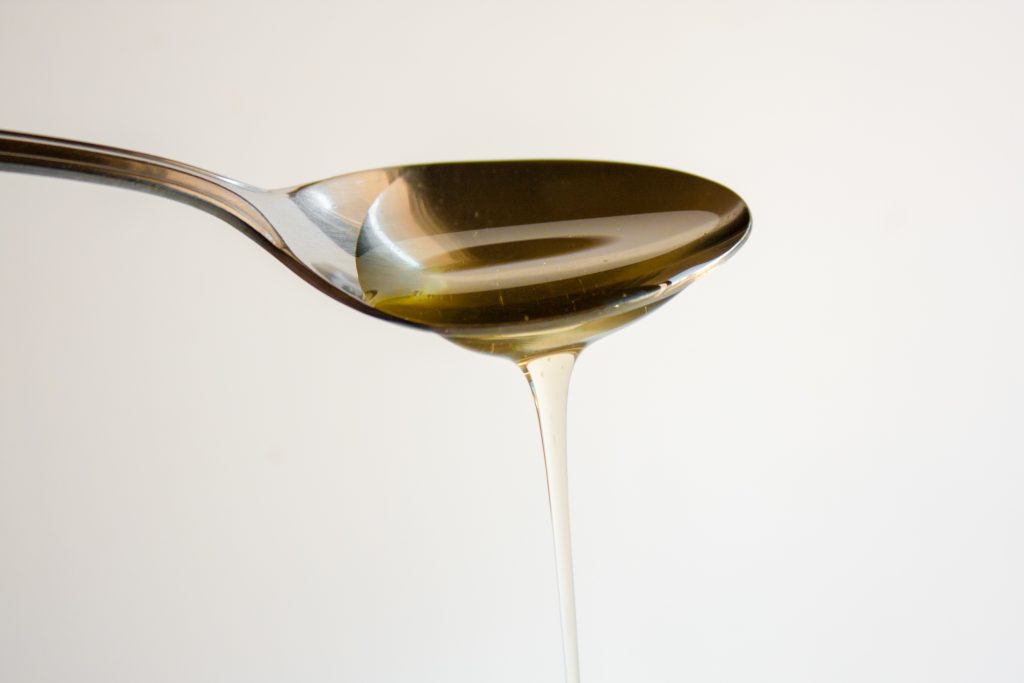
Agriculture The science and art of growing crops and raising livestock; farming. agclassroom.org Learn about wheat agriculture: Visit farms, and meet farming families.
View The Journey of Wheat-Field to Table
Download an Infographic, Wheat’s Journey From Field to Table
Explore sustainable agriculture definition, practices and milling companies: Ardent Mills , ADM , International Food Information Council, Graincraft, Stone Buhr, Washington Wheat Foundation. Sugar beet and sugar cane farmers, Vanilla farmers
Alkaline pH greater than 7. Alkalis such as baking soda (bicarbonate of soda) neutralize acids and react with acidic ingredients as a leavener.
All-purpose flour Wheat flour milled from hard wheat or a blend of soft and hard wheat. Used in homes for some yeast breads, quick breads, cakes, cookies, pastries and noodles. All-purpose flour may be bleached or unbleached. Both may be enriched with four vitamins (niacin, riboflavin, folic acid, and thiamin) and iron. Wheat Foods Resource Wheat Flour 101
See Wheat Flour Resources, Baking Flour 101, and Flour Food Safety
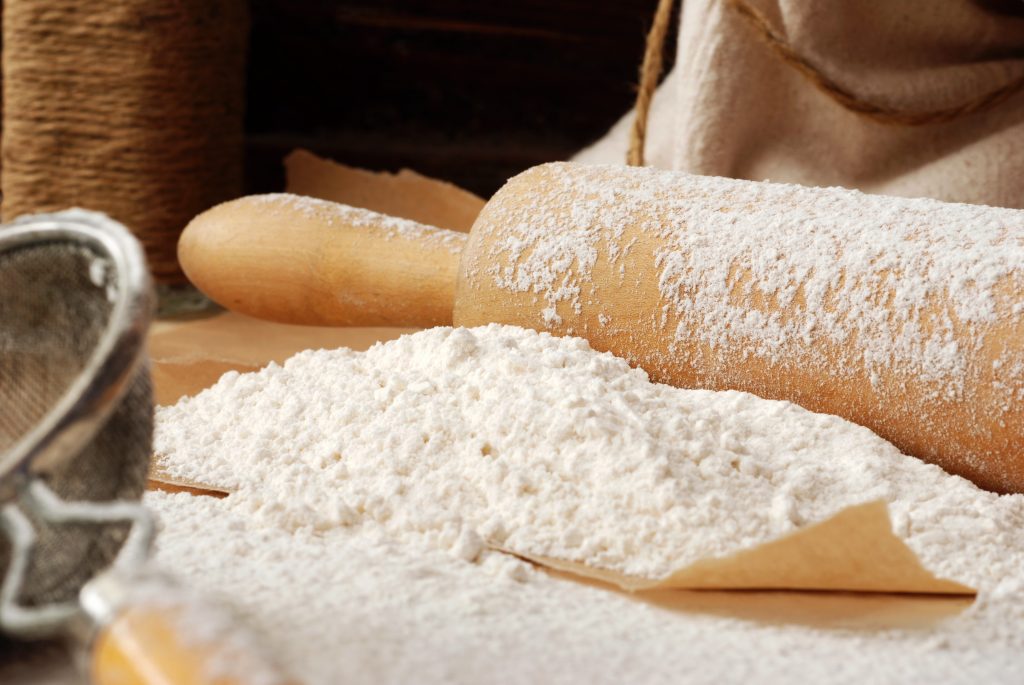
Almond Paste – A paste made by mixing blanched ground almonds with sugar. Coarser than Marzipan, this product is generally used as an ingredient or filling for sweet treats. It adds a delicious nutty flavor to bars, cakes, and cookies. See: King Arthur Baking Almond Cloud Cookies
Altitude (above 3,500 ft.) adjustments may be needed in baking, cooking time, temperature and recipes. For example:
- Water boils at 212 ̊ F below 2,000 ft. and more quickly from 3,000 to 10,000 ft. (208 ̊-194 ̊ F.).
- Boiling (eggs, pudding/pie filling) will take longer.
- Leavening gases in breads and cakes expand more; breads will rise faster—use slightly cooler liquids to slow fermentation; punch down twice. Use only baking powder when both soda and powder are in recipe—use sweet milk not buttermilk in this case.
- Flour will be dryer and more absorbent at altitude—use
1 T. more at 3,500’, 1 T. more every 1,500’ more altitude. Add 1-2 T. more liquid after 3,000’; 1 1/2 tsp more each 1,000’ higher. Egg may be used as liquid to add structure. - Cakes may need less baking powder (1/8 to 1⁄4 tsp), less sugar (1 to 3 Tbsp. per cup).
- Increase baking temperature slightly, 15 to 25° F.
- Egg Whites: beat only to soft peaks, not stiff.
More: High Altitude Baking Series. Colorado State U. Extension and New Mexico State University Extension, and High Altitude Baking guide at King Arthur Baking.
Ancient grains All whole grains are considered ancient because we are able to trace their roots back to the beginning of time (OldwaysWholeGrainsCouncil). The term “ancient grains” is used to reference grains and also seeds that have provided food for humans and have had minimal changes to their genetic coding by selective breeding. These include modern wheat’s family ancestors- einkorn, emmer/farro, Kamut®, and spelt; heirloom varieties of black barley, red and black rice, and blue corn; sorghum, teff, millet, quinoa, amaranth and less commonly, buckwheat and wild rice.
More info at Northern Crops Institute
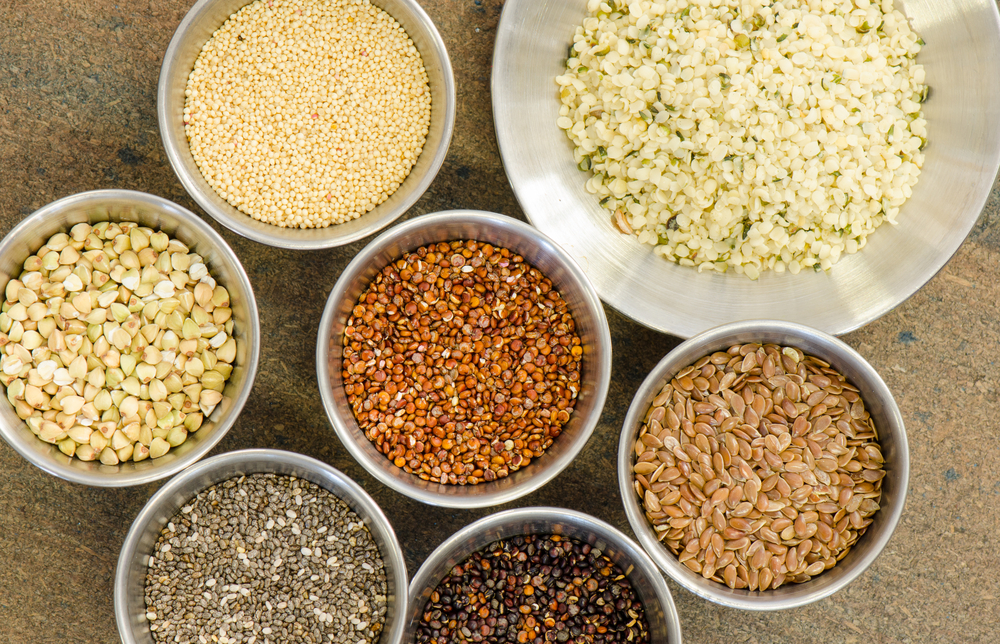
Apron A cloth or plastic cover garment bakers wear for both food sanitation and to protect clothing.
Ascorbic acid The scientific name for vitamin C; it is used in bread flour for its gluten development properties. It conditions the dough to obtain better loaf volume.
Artificial sweeteners or Non-nutritive or Non-caloric sweeteners High-intensity sugar substitutes (contain no nutrients) and require additional ingredients to work well in baking. Only sucralose and stevia (a natural sweetener) are GRAS-approved to use in baking. See current labeling and use concerns
Artisan (baker) Skilled craftsman or trade; baker who produces bread or bakery goods using production methods that are hand-made. Often refers to crusty breads, sour dough, hand pies, and European low-ratio cakes and desserts. View some examples at: Red Star Yeast, Whole Wheat Artisan Bread, and King Arthur Baking.
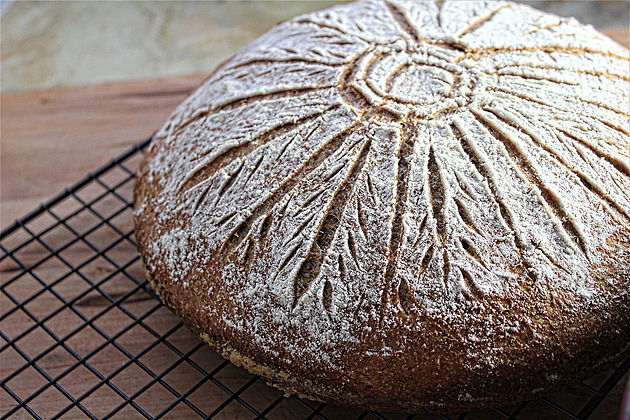
Source: Panhandle Milling Artisan baker, Stephanie Petersen
Autolyse When the flour and water from a bread recipe are mixed together before the salt and yeast or starter are added. Typically the mixture is allowed to sit for 20 minutes to 1 hour before adding the rest of the ingredients. This step allows the flour the to fully hydrate and jump-starts the gluten formation. This is often used in high hydration artisan-style breads, such as sourdough bread and whole grain baking. Read more on the Autolyse Method here
B
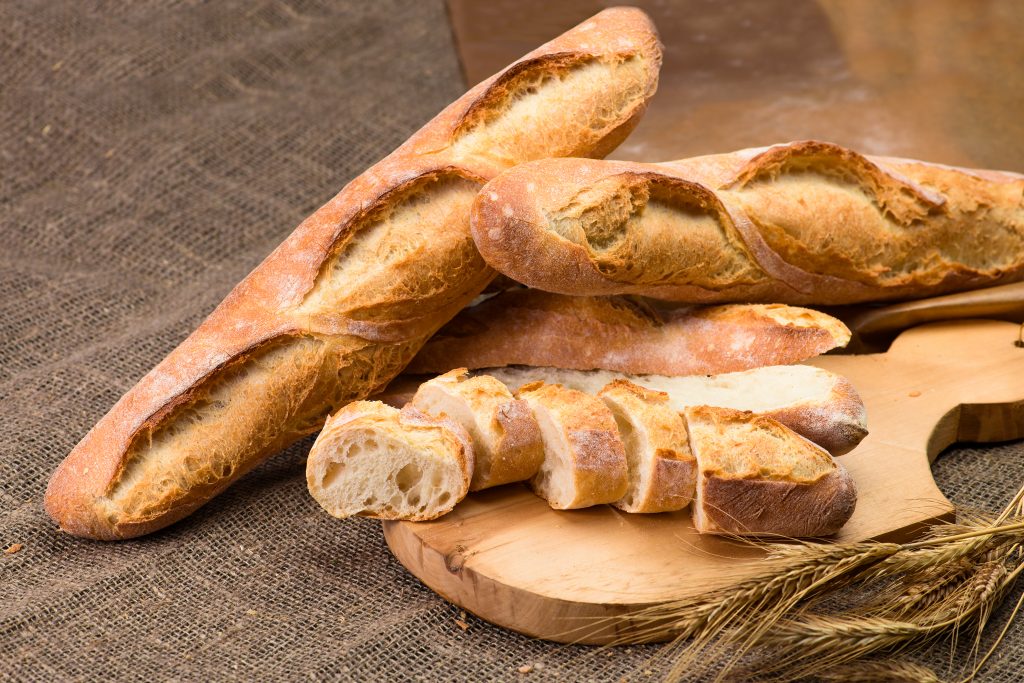
Baguette Long, thin, crusty, open crumb cylindrical wheat flour yeast bread the French made famous. Follow the steps from Baker Bettie, King Arthur Baking. Learn how to shape baguettes.
Bake To cook by dry heat in an oven. When applied to meats and poultry, this cooking method is called roasting.
Baker: A person who mixes and makes breads, pastries, cakes, crackers at home or as a trade Resources: Home Baking Association, Kansas State Bakery Science, Future in Baking, Baking School on-line, How-to with BiggerBolderBaking
Baker’s Percent or Baker’s % In baking formulas primarily based on flour, each ingredient’s weight is measured as a percentage of the total flour weight (100 percent). This “baker’s math” is used to calculate each ingredient represented in a recipe or formula as a percentage of the amount of flour in the recipe (which is 100%). See below:
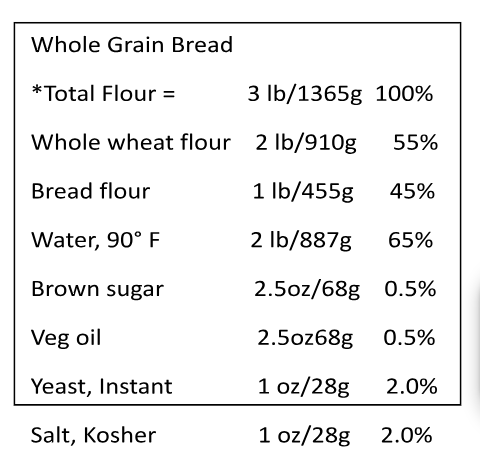
Learn more from Baker Bettie,
King Arthur Baking, and MakeBread.com
Baking Food Safety: refers to the practices and guidelines that ensure baked goods are prepared, handled, and stored in ways that prevent contamination and protect consumers’ health. This includes proper sanitation of equipment and surfaces, accurate measuring and cooking temperatures, safe handling of raw ingredients (such as eggs and flour), and proper storage of finished baked products. Baking food safety is essential for preventing foodborne illnesses and promoting a safe kitchen environment for bakers of all ages.
Baking mix A combination of pre-measured baking dry ingredients (Ex: flours, meal, leavening, sugars, salt, spices). Visit Jiffy Mix, Shawnee Milling Company, Homegrown Family Foods, self-rising flour, self-rising cornmeal and self-rising Cornmeal Mix (one of the oldest convenience mixes)
Baking pan Available in a variety of shapes and sizes for baking specific cakes, cookies, biscuits, breads, pies, and specialty goods. Test kitchens use heavy-duty steel (for strength and durability), and aluminum (for superior conductivity) and glass to formulate standards for baking time, temperature, and even baking/browning. Metal baking pans and glass bakeware. See Why Bake in Glass.
Baker’s sugar Professional quality granulated white cane sugar that is ultra-fine and uniform grain size to mix, blend and melt more evenly in baked goods and confectioneries including cakes, cookies, pastries, brownies, frostings, glazes and meringues. See Types of Sugar. It is also used to coat donuts and cookies. See Homemade Baked Sugar Donuts recipe.
Baking powder A leavening agent that is a base (such as baking soda) combined with an acid salt (such as sodium aluminum sulfate NaAl(SO4) (2) and inert ingredients (corn starch, calcium carbonate) that buffer the active ingredients. Baking powder reacts in the presence of moisture and heat to produce carbon dioxide (CO2). Baking powders are: Single action: releases carbon dioxide (CO2) immediately when moistened, Slow action: requires heat for release of CO2, Double acting: releases some CO2 when mixed and more when heated in oven.
Baking soda A base, alkaline In nature, formed when sodium carbonate (purified form of mineral trona) is mixed with carbon dioxide and water to form sodium bicarbonate.
| Na2CO3 | + | CO2 | + | H20 | = | NaHCO3 |
| sodium carbonate | + | carbon dioxide | + | water | = | sodium bicarbonate |
Baking soda is the source of CO2 gas in leavening systems. It neutralizes acids in the batter, adjusting the final pH of baked goods. Baking soda is not the same as baking powder. Learn the Difference.
Baking stone Quarry tile (unglazed clay) or stoneware placed 2-3 inches between stone and oven walls for air flow; preheat stones, bake directly on stone.
Baking sheet
A sheet of metal that is rigid and is used for baking cookies, breads, biscuits, etc., usually with one or more edges that is turned up for ease in removing from the oven. Types include shiny, heavy-gauge steel and aluminum, the standard used in most test kitchens for even baking and browning. Darkened, heavy-gauge pans will produce especially crisp exterior crusts desired. Insulated baking sheets are two sheets of aluminum with air space between, and are especially good for soft cookies or tender-crust breads or rolls. Bakers typical sizes are full (18 in X 26-in), Half sheet pan, 18-in X 13-in) or quarter (9 ½ in X 6 ½ in) sheet pans.
Jelly roll pans are sometimes used in home baking as a sheet pan- they are 15-in X 10-in. Cookie sheet pans may be similar to a half sheet pan in size, but would not have sides.
Bannock An ancient flat bread made with oatmeal or wheat flour; baked on griddle, skillet or in oven. Indigenous people of North America baked Bannock (Cree word is pahkwesikan- Book source, Awasis and the World-Famous Bannock by Dallas Hunt) Scottish bakers also bake Bannock.
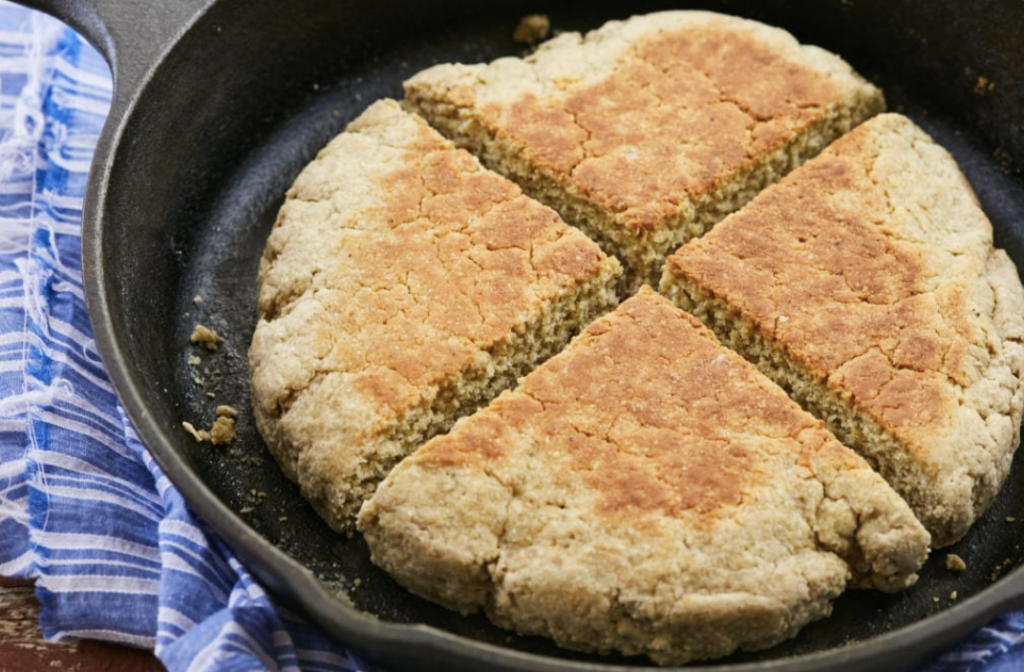
Barbados sugar Muscovado sugar. British specialty dark brown sugar has a strong molasses flavor. See Types of Sugar.
Batard A long loaf (thicker and stubbier than a baguette). See the following video.
Batch A single batter or dough recipe.
Batter Thin mixture of flour and water or other liquids that can be poured or spooned into pan or on a griddle.
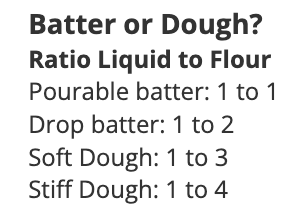
Beat To agitate one or more ingredients rapidly using a brisk up-and-over motion to add air into a mixture using a spoon, whisk, rotary beaters or electric mixer.
Bench The counter or surface bakers use to work with dough.
Bench knife Hand-held dough dividing tool safe to cut through dough on counters and work bench. King Arthur Baking resource
Bench time Allowing yeast dough 5 to 15 minutes resting time after fermentation, punching, dividing and before shaping to allow gluten to relax. Keep dough covered.
Biga (bee-guh) an Italian pre-ferment prepared before the full dough is developed for lean breads such as ciabatta. Step 1: part of the flour, water, and yeast that will be used in a bread dough are combined many hours before the final dough is mixed and allowed to ferment. The Italian biga is similar to a French poolish but has a lower ratio of water. See step-by-step, Baker Bettie Ciabatta and Red Star Yeast resource
Bind To thicken or smooth out the consistency of a liquid.
Biscuit A small tender, flaky quick bread, usually leavened with baking powder or using self-rising flour and is usually a savory (not sweet) hot bread served with meals. See Chef Devin Donley, Biscuits 101.
Bittersweet chocolate Baking chocolate containing a minimum 63-72% chocolate liquor. Baking chocolate will have no added flavorings, milk or other ingredients. (HBA resource: A Baker’s Dozen Chocolate IQ Chart, Lab 11). Access Ultimate Guide to Types of Baking Chocolate and video.
Black Walnuts – A bold flavor ingredient nut used in baking and cooking. This nut is foraged by hand and one of the only commercially available nuts that are Native to North America. Learn More
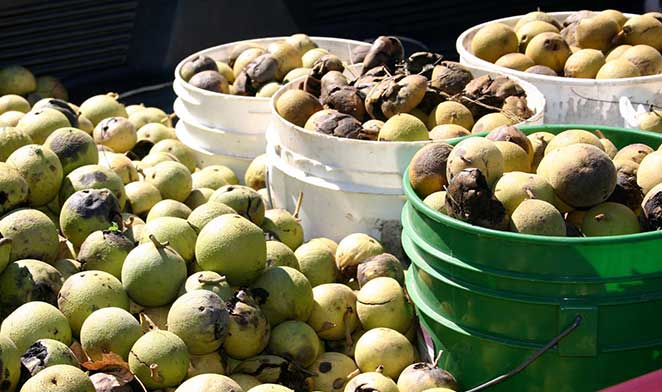
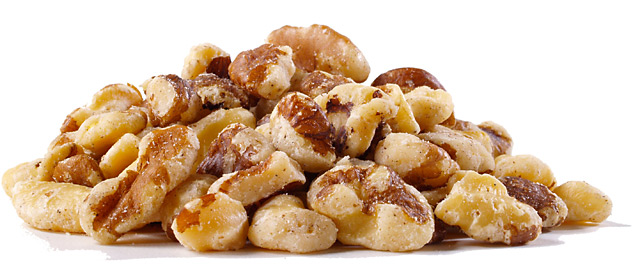
Black Walnuts in husks; black walnuts hulled
Blend Mix to combine two or more ingredients with spoon, whisk, electric mixer or processor.
Blind Bake A method of pre-baking a pie or tart crust before adding the filling. Recipes will often instruct to blind bake the crust when the filling does not need to be baked or if the crust needs longer to bake than the filling. How to Blind Bake a Pie Crust
Bloom, bread In bread-baking, bloom refers to the attractive, brown color of the crust of a well-baked loaf of bread.
Bloom, chocolate Pale, grayish streaks or blotches on surface of chocolate indicating cocoa butter has separated from chocolate; chocolate was stored in an environment that was too warm; it can still be used.
Bloom, yeast To activate or rehydrate yeast in small amount of water and a pinch of sugar until it “blooms” and is obviously active. See method , Baking with Yeast: Step-by-Step Guide | Red Star® Yeast (redstaryeast.com)
Boil To cook in liquid that is heated until bubbles rise to the surface and break. Bubbles form throughout the mixture. Temperature: 212 ̊ F or 100 ̊ C (Also see Altitude).
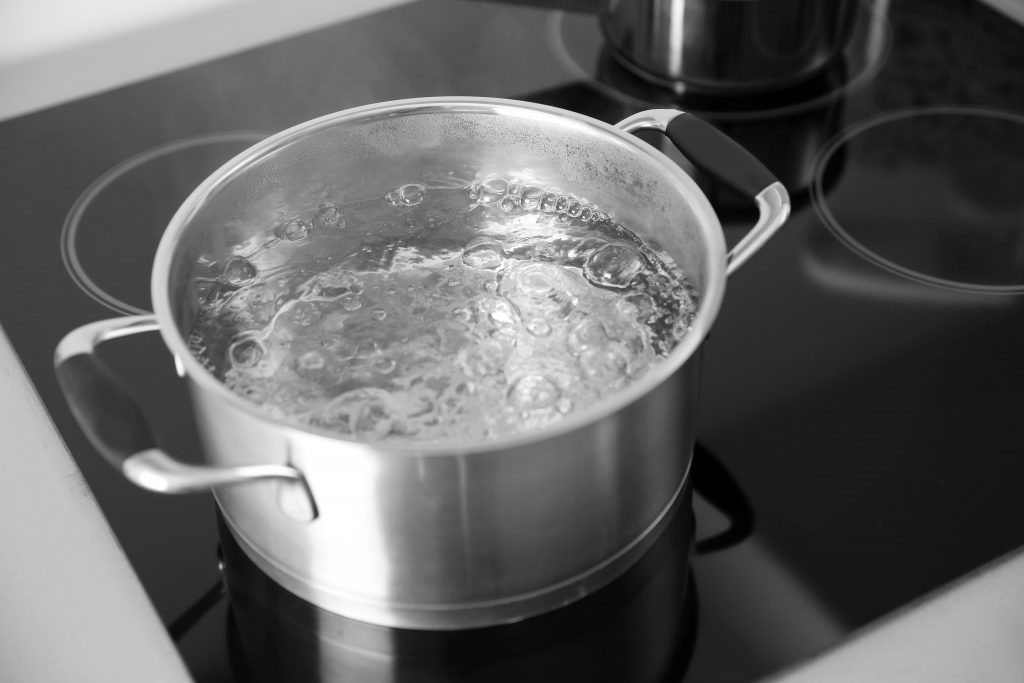
Boule (miche) Round loaf; taut skin stretched perfectly over a dome of bread dough, sealed on the bottom. Baker Bettie shows how to handle and shape boule.
Bread Baked foods produced from dough made of flour, water, salt and other optional ingredients, and leavened by yeast or other leavening agents.
Braid To weave together three or more long pieces of dough. View simple Three Strand, a Braided Loaf; a Six Strand Braid.
Bran The outer layers of a kernel of grain that lie just below the hull. “Miller’s bran,” raw bran layers removed from the grain kernel. About 14.5 percent of whole wheat flour is bran and provides dietary fiber and nutrients. See A Kernel of Wheat
Bread flour Unbleached, enriched or whole wheat flour high enough in protein (11% or more) for yeast bread dough development and preferred for use in bread machines. Texas Wheat Resource Flour 101
Bread scoring 1. Evaluation of finished baked product to determine quality. 2. Slashing the surface (top) of loaves after proofing and prior to baking to allow for expansion as the loaf is baked. Techniques.
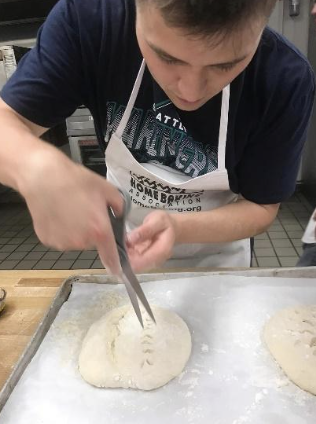
Break The rough portion of the bread crust formed during oven spring between the pan’s edge and the curve of the loaf’s top. Break may occur on both sides or one side only.
Breakfast The first meal of the day.
Brown Color that develops on baked or cooked surface or to a food (such as meat, butter or flour) by applying heat during baking and roasting.
Brown sugar Types of brown sugar include light and dark brown sugar containing varying levels of brown sugar syrup or molasses and typically moist enough to pack; Turbinado (also called Demerara and Raw cane sugar) has larger crystals, golden brown color and is processed minimally; Free-flowing brown sugar that has moisture removed in a special process to retain the brown sugar flavor. Muscovado, a very dark brown unrefined cane sugar with the molasses not removed- its crystal are slightly coarser (sandy) and stickier. Types of Sugar and About Brown Sugar. See In a Pinch-Make Brown Sugar at Home
Browned butter Butter heated until browning begins, then cooled before preparing recipe/formula; adds delicious flavor in baked goods; Learn how.
Brownie A dense, chewy, cake-like cookie that is generally chocolate-flavored and colored (hence the name), and cut in bar shapes to serve.
Buckwheat flour A gluten-free flour, groat or kasha made by grinding hulled buckwheat seeds. It is not a relative of wheat. Originating in Russia, buckwheat has a distinctive flavor and is used in pancakes and some baked goods, such as multi-grain breads, Asian noodles (soba) and Russian blini are made with buckwheat flour. Learn more about Buckwheat and Buckwheat Flour (Photo: Whole Grains Council)
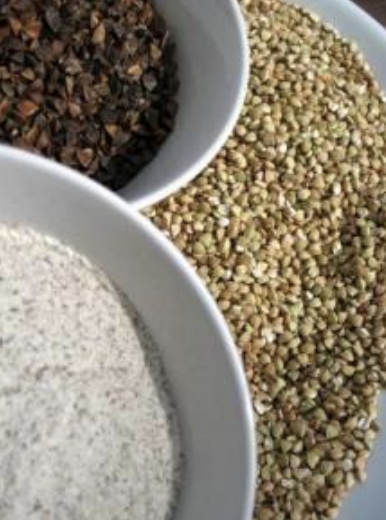
Bulgur Whole wheat kernels that have been steamed, dried, and cracked. Bulgur may be soaked or cooked and added to baked goods. Bulgur also may be ground into flour.About Bulgur.
Butter Produced by churning cream into a semi-solid form. By U.S. standards definition, it is 80 percent milk fat, with the remaining 20 percent consisting of water and milk solids. Butter for baking may be salted or unsalted and is valued by most bakers for its irreplaceable flavor and ability to create flaky layers, crispness, tenderness, to carry flavors, and provide golden-brown color. Visit All About Butter.
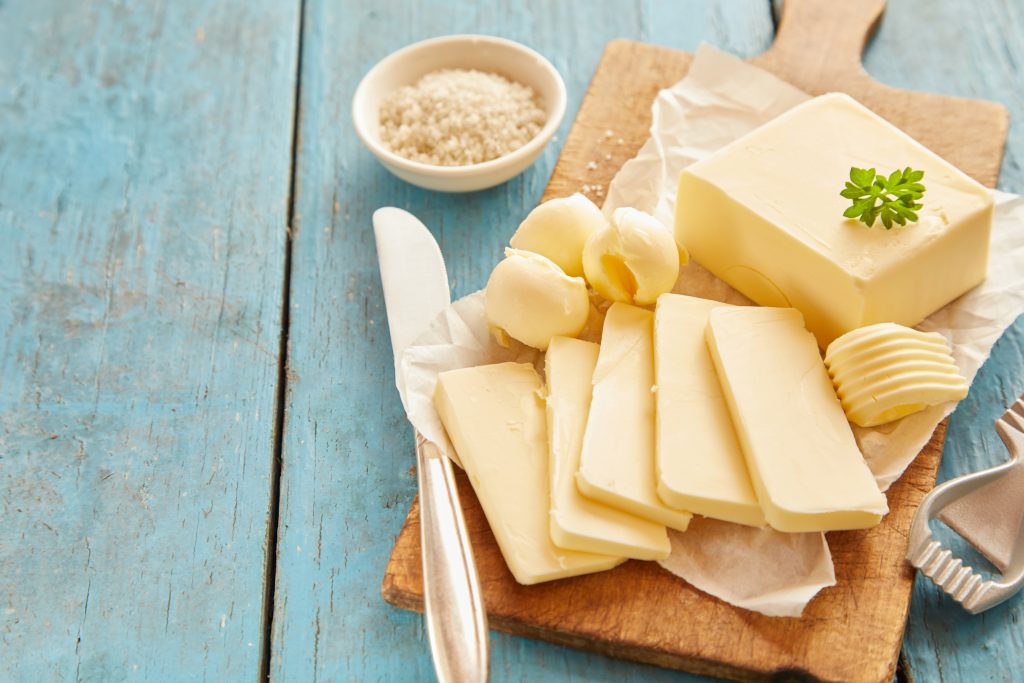
Butterhorn roll Also called Crescent roll. Rich roll dough rolled into a large circle, spread with butter and cut into 12 even triangle portions, rolled up (or “flipped” from the wide edge to the point. Photo (below) and recipe. Shaping Butterhorn Rolls Step by Step
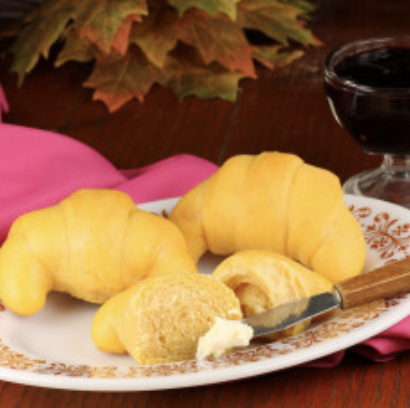
C
CO2 Carbon dioxide; the gas released from leavening reactions and fermentation that creates bubbles and space in a batter or dough.
Cacao Tropical evergreen tree cultivated for its seed pods from which cocoa powder and cocoa butter are produced. Explore Cocoa 101, History and Fun Facts.
Cake and pastry filling– Real fruit or nut fillings specially developed to use in baked goods to fill or layer in specialty cakes, cookies, breads or pastries without weeping or running. Fillings may include canned almond, apricot, cherry, poppy seed, prune plum, and raspberry or homemade, such as Vanilla Custard or Cherry and Fruit Pie Filling.
Cake flour Fine-textured, silky flour milled from soft wheat, with a low protein content for making cakes, cookies, pastries and some breads. Learn more, Flour 101
Capping When yeast loaves are under-proofed and the interior pushes up the top crust leaving a rough, sharp edge along the side of the loaf having the appearance of a “cap.”
Caramelization To heat sugar until brown and a characteristic flavor develops; occurs at 300 ̊ F.
Celiac Disease A hereditary autoimmune disease where gluten adversely affects the small intestine. Symptoms will vary among people. It is lifelong, sometimes fatal, and those affected must avoid gluten containing grains: wheat, rye and barley and wheat’s ancient ancestors emmer, einkorn, spelt, and kamut. Celiac disease affects approximately 1 percent of the U.S. population; many go undiagnosed. An intestinal biopsy is the gold standard for detecting celiac disease. Resources available from National Celiac Association.
Cereal grain Cereal refers to grain and foods derived from them; the word cereal comes from Ceres, a pre-Roman goddess of agriculture. Learn more and Northern Crops Institute and Ardent Mills Flour and Grain Innovations. Chemical leavening The reaction of a leavening base (such as baking soda) with a leavening acid (such as sodium aluminum sulfate) in the presence of moisture and heat to produce carbon dioxide gas. Learn more
Chemical leavening The reaction of a leavening base (such as baking soda) with a leavening acid (such as sodium aluminum sulfate) in the presence of moisture and heat to produce carbon dioxide gas. Learn more
| NaAl(So4)2 | + NaHCO3 | NaX + H2O + CO2 | |
| (Acid Salt) | (Soda) | (Heat & Moisture) | (Neutral Salt) |
Chill Make mixture or cooking bowl cold by placing in refrigerator or in ice.
Chocolate From the Aztec word xocolatl, meaning bitter water. A food derived from the cacao bean fermented, dried, roasted, ground and processed into cocoa powder, and a liquor used to make a variety of chocolate products: Bittersweet, dark, couverture, milk, semisweet, white, unsweetened. (HBA Resource: A Baker’s Dozen Labs, Lab 11, Chocolate Chart) Access Ultimate Guide to Types of Baking Chocolate and video.
Chop Cutting food into small bits before adding to dough or as a topping.
Clarify To make a substance clear or pure such as clarified butter.
Cloverleaf roll Dinner rolls shaped by placing three small equal-sized balls of dough in a greased muffin cup and proofing until light before baking. View how to shape. Cloverleaf and Fan Tan Buttermilk Rolls
Coat To thoroughly cover a food with a liquid or dry mixture.
Cocoa (also Cocoa Powder) An unsweetened baking ingredient produced from hulled and roasted cacao beans or nibs. The nibs are ground to a chocolate liquor (aka unsweetened chocolate), a paste, that is then pressed to remove the liquor’s fat (cocoa butter). This de -fatted mass that is left is finely ground to produce natural cocoa powder. If it is further “dutch-processed” it has been “alkalized” and the acidity reduces. (HBA resource: A Baker’s Dozen Labs, Lab 11 and Baking Cocoa Types and Leavening video). Photo credit and resource: King Arthur Baking – Types of Baking Cocoa Explained
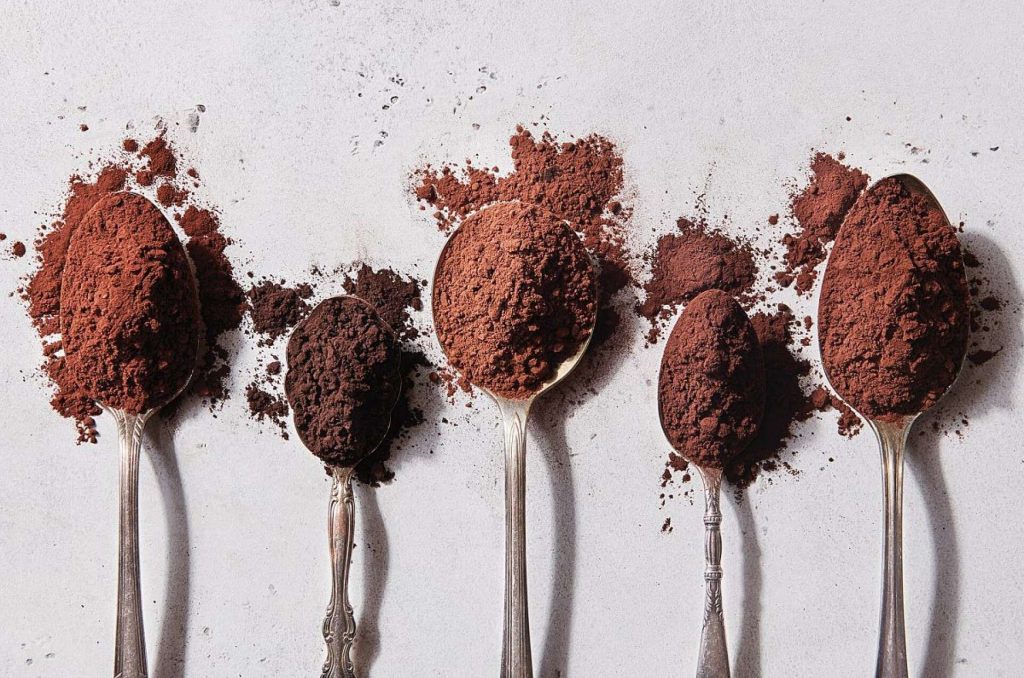
Cocoa butter The portion of fat in the cacao bean.
Coarse Refers to the crumb structure of some baked goods.
Coarse salt Large crystals of salt, such as Kosher, rock salt, some sea salts, pretzel salt. (HBA Resource, A Baker’s Dozen Labs, Lab 10) Read Is there a best salt for baking?
Coconut oil Made from pressing the coconut meat. Coconut oil is a saturated fat and solid at room temperature. Refined coconut oil has a more neutral flavor and higher smoke point than unrefined coconut oil.
Combine (v.) To mix or blend two or more ingredients together.
Conditioned raisins Moisten raisins before mixing into a batter or dough to prevent the raisin from grabbing moisture from the mixture or baked product, making the baked product crumbly. How to condition raisins: Cover raisins in tap water (80° F.) for 5 to 10 minutes; drain off water. Measure raisins needed; place remainder in sealable food container or bag. Store refrigerated.
Confectioners or powdered sugar A granulated sugar that has been crushed into a fine powder. A small amount (about 3 percent) of corn starch is added to prevent clumping, Learn more from Sugar Association
Consumer A person who buys goods or services for his or her own needs and not for resale.
Convection oven A gas or electric oven equipped with a fan that continually circulates the hot oven air around the product. Circulating hot air allows products to bake on several racks at one time. Oven temperature can usually be reduced by 25° F.
Cookie A flour-based, sweet, hand-held small cake (from the Dutch word “koekje,” meaning “little cake”).
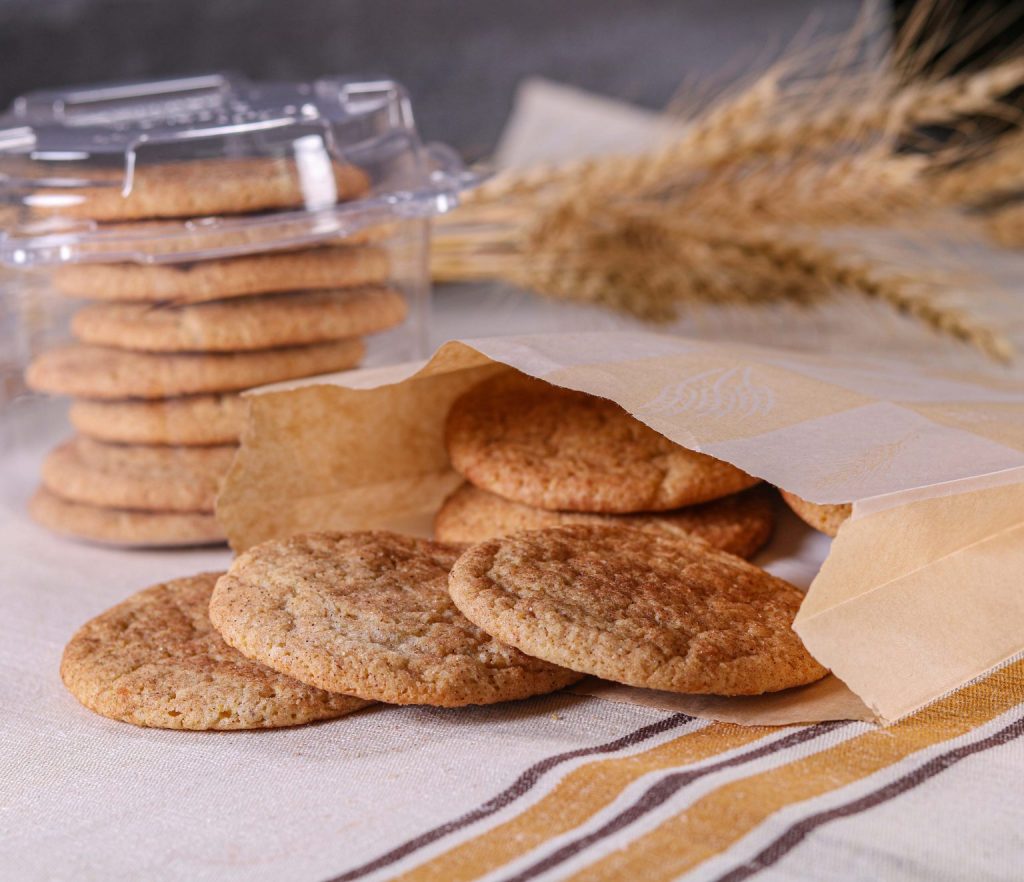
Cookie sheet or half sheet pan A flat, rectangular baking pan made of steel and/or aluminum that is rigid. Sizes range from 10 x 8 inches to 20 x 15 inches. A cookie sheet is designed with two, non-edged sides so cookies can slide off either side for easier removal or, may also have four sides (5/8 to 3/4-inch); jelly-roll and half sheet pans also serve as cookie sheet pans.
Cool To let food stand until it no longer feels warm to the touch. Baked goods are cooled on wire racks to avoid soggy bottom crusts; cool baked goods before wrapping and storing to a minimum of 100°at center. Do not store yeast breads or rolls in a cool or refrigerated environment to avoid staling.
Cooling rack A rectangular grid of thick wire with “feet” that raise it above the countertop. They are used to cool cakes, cookies, and other baked goods when they come out of the oven. Cool products in pan and remove from pan as recipe directs.
Core (v.) Remove the seeded, inner portion of a fruit.
Corn bread Quick bread in which half or more of the flour used is white or yellow cornmeal. It may be thin and crisp or thick and light. In addition, popular types are hush puppies, Johnnycakes and spoon bread. Learn more: Jiffy Mix, Shawnee Milling, Sunflour, Homegrown Family Food Video: How to make
Corn flour Finely ground de-germed corn, it has the flavor of corn and is excellent in cornbread, muffins, waffles, Southern chess pie, and blended with cornmeal. In the U.K. “cornflour” refers to cornstarch, but they are not the same product in the U.S. Source: MasterClass What is Corn Flour?
Cornmeal Dry de-germinated or whole grain corn kernels (yellow, white or blue varieties ground into fine, medium or coarse meal. Learn more from North American Millers Association/NAMA
Cornmeal mix Developed after WWII, it is a blend of cornmeal (white or yellow), soft or hard wheat flour, leavening and salt for quick corn bread preparation. It differs from self-rising cornmeal which does NOT contain flour. Sunflour Flour, Homegrown Family Food, Shawnee Milling
Corn starch The fine, powdery white starch obtained from wet milling corn and used as a thickener for pie fillings and puddings. Cornstarch may be referred to as cornflour in the U.K. but they are not the same product in the U.S.
Corn syrup Corn syrup is a mildly sweet, concentrated solution of dextrose and other sugars derived from corn in a wet milling process. It is naturally sweet and is not the same as High Fructose Corn Syrup (HFCS). Corn syrup contains between 15% to 20% dextrose (glucose) and a mixture of various other types of sugar. Learn more: Corn syrup Background
Light corn syrup (clear and colorless) – a mixture of corn syrup flavored with salt and pure vanilla contains no high fructose corn syrup.
Dark corn syrup A mixture of corn syrup and a small amount of refiners’ syrup (a cane sugar product with a molasses-like flavor). Caramel flavor, sodium benzoate (a preservative), salt, and caramel color are added. Dark corn syrup has a rich brown color and distinctive flavor.
Courverture chocolate High quality chocolate used for tempering and glossy coating. In the U.S. it must contain a minimum of 35 percent cocoa solids and 31 percent cocoa butter but may range up to 39%. (See resource A Baker’s Dozen Labs, Chocolate IQ Chart, Lab 11). Learn King Arthur Baking Guide to Tempering Chocolate
Cream (v.) also creaming. To work to mix and aerate (with spoon or mixer) one or more foods until soft and creamy. In baking, granulated sugar and room temperature butter are creamed for many types of cookies, cakes and some quick breads.
Cream of tartar An acidic salt—potassium hydrogen tartrate (also referred to as tartaric acid); stabilizes beaten egg whites and leavens some baked goods. Check out this handy resource from Baker Bettie!
Crepe (KRAYP) The French word for pancake; paper-thin, flexible egg-rich pancakes used to wrap or fold around sweet or savory ingredients as a first or main course.
Crescent roll A flaky crescent-shaped bread roll made of a yeast dough similar to puff pastry. Also called a Butterhorn roll; view the following video
Crumb The interior of baked goods—not the crust; interior texture formed by air cell pockets trapped inside a webbing of starch and protein gelatinized by baking.
Crush To pulverize, as with herbs and spices used in baking.
Crust The caramelized crisp or chewy outer layer of a baked product that covers the crumb or more tender inside. The crust also refers to a pie or pastry shell or wrapping.
Cultivation The process of preparing soil and growing plants or crops. Learn Kansas Wheat, Colorado Wheat, Nebraska Wheat, North Dakota Wheat Commission, Oklahoma Wheat Commission, South Dakota Wheat, Texas Wheat, Washington Wheat Foundation
Cut-in To distribute a solid fat (shortening, butter, lard) into flour using a pastry blender (up and down motion), food processor, fingers or two knives (crisscross motion), until fat is divided evenly in the flour in pea-sized or smaller pieces. View how:
D
Danger zone The temperature at which perishable food should not be held or left out of refrigeration for any longer than 2 hours—The Danger Zone for food safety is 40° F. to 140° F.-– perishable foods held in this “zone” for over 2 hours should not be eaten. Learn more from Fight Bac
Dark chocolate Bittersweet, semi-sweet, or sweet dark chocolate; all contain cacao beans, sugar, an emulsifier such as soy lecithin to preserve texture, and flavorings such as vanilla, but do not contain milk solids. They are distinguished by the amount of cocoa powder: 30% (sweet dark) to 70%, 75%, or even above 80%, for extremely dark bars. (See Chart, Lab 11)
Degerminated To remove the germ from a grain kernel, leaving bran and endosperm. View here
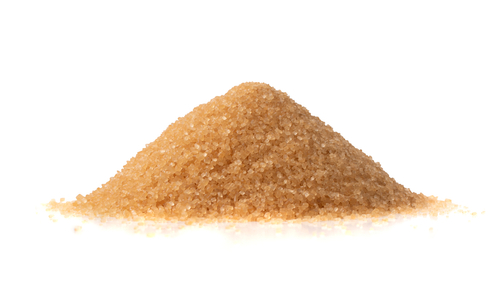
Demerara sugar Demerara cane sugar is crystallized from the initial pressing of pure cane and has a light golden color from the molasses left behind after minimal processing. Demerara
is a slightly larger crystal than granulated sugar with a delicate crunchy texture. It is perfect for baking, sweetening your coffee or as a topping on your cereal, fruit or desserts. Learn more: C&H Sugar, Domino Sugar, Sugar Association
Dextrose Also dextroglucose and known as glucose, this sugar is the chief source of energy in the body. Glucose is a simple sugar or monosaccharide and naturally occurs and is derived from plant starches such as corn.
Dissolve Stirring a dry substance into a liquid until solids are no longer remaining. (Ex: stirring sugar or yeast into water).
Divide Equally portioning a dough or batter before shaping or panning prior to baking. Also called “scaling” for equal portions.
Dock A baking technique in which regularly spaced holes are poked all over the surface of a dough to promote a crisp baked surface (crackers, pet treats, pie shells, all may be docked before baking).
Docking Slashing or making incisions in the surface of bread or rolls for proper expansion while baking. Done just before baking.
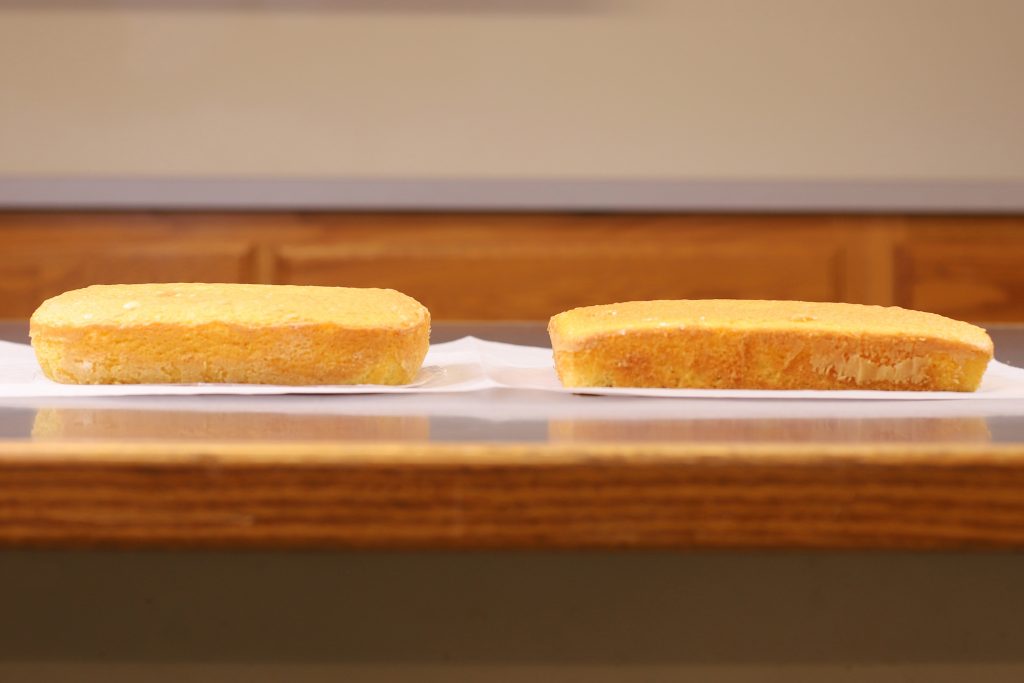
Domed Cake – Result of a cake cooking too quickly. The edges of the cake bake and set earlier than the middle of the cake which can make stacking and icing the cake more challenging. Reference: Why Bake in Glass?
Dot To place small dabs or pieces of butter or batter over the surface of a food, such as with a pie, just before the top crust is added and baking begins.
Double in bulk Refers to expansion of gluten cells in yeast bread that has risen and is ready to be punched down. Recipe will give a range of time. Varies with dough and environment’s temperature. Bakers use a “dough ripeness finger test”: gently press two fingers into dough, if marks remain unchanged, dough is ready to punch. View:
Double in size Refers to the final rising (proofing) before bread is baked. Some bakers make a template for a guide— when bread is a certain height above the pan edge. Look for recipe or formula guide: “3/4 proof=half again as large” or “full proof=almost double in size.” May touch side of loaf very gently—if slight print remains, bake. View:
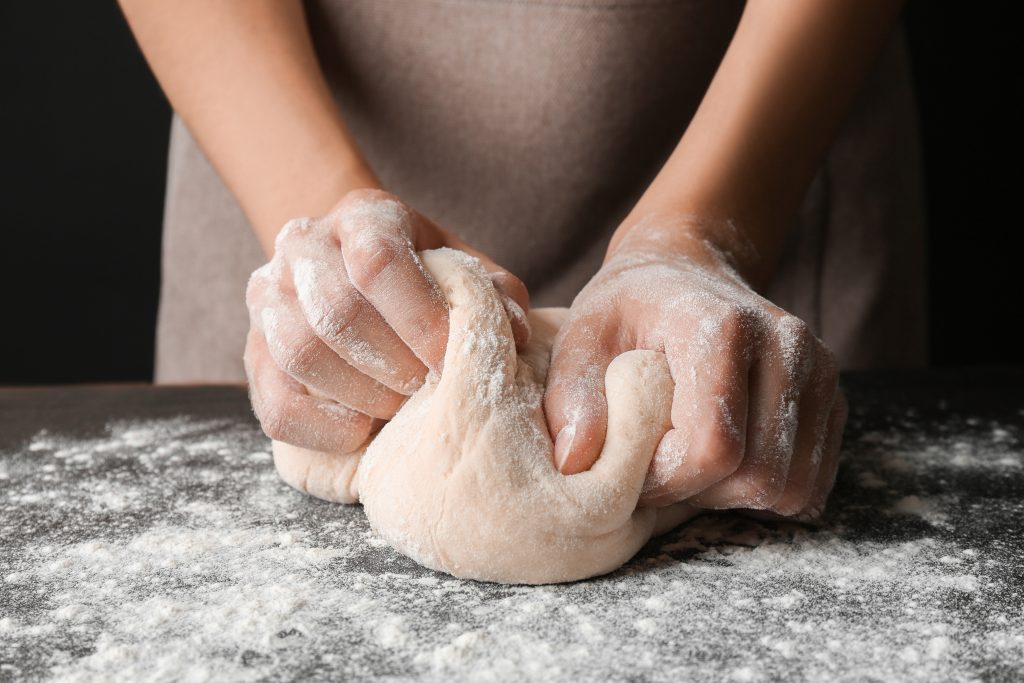
Dough A mixture of flour and liquids, and may have other ingredients, thick enough to be handled, kneaded or shaped.

Dough scraper, dough or bench knife A flat, heavy metal blade (about 3 X 5-inches) with straight sides, sharp corners and a handle on top edge for moving, kneading, clean-cutting dough, incising, or even cleaning work surfaces.
Drain To remove liquid from a food product.
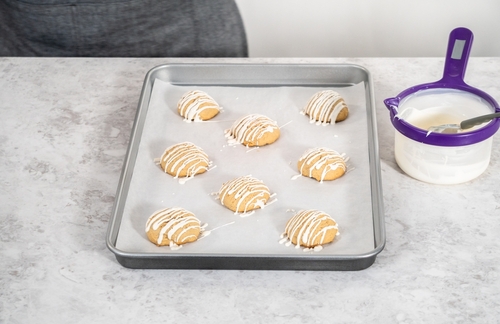
Drizzle To pour a light amount, from a spoon, over surface.
Drop To deposit even portions of dough on a baking sheet using spoon, scoop or batter dispenser.
Dry ingredients Refers to the ingredients in a recipe, such as flours, sugar, leavening, salt, baking cocoa, spices, or herbs, that may be blended before adding to another mixture in the recipe.
Dry measure also Dry measuring cups.
Dry measuring cups Straight-sided, graduated sizes of cups with handles attached at the top lip. Common U.S. cup sizes are 1/4, 1/3, 1/2, 1 and 2 cup. They are used to measure a standard amount of dry ingredients, such as flour, sugar, cornmeal, or brown sugar, for home baking recipes. The dry ingredients are spooned into the cup and leveled off with a straight-edged utensil. View learning activity-Scoop, Spoon, Scale
Dutch-processed cocoa Unsweetened baking cocoa that is further processed with an alkali to neutralize cocoa’s natural acidity; Substitution guidelines: 3 tablespoons (18g) Dutch- processed cocoa = 3 tablespoons (18g) natural cocoa powder plus pinch (1/8 teaspoon) baking soda.
Dust To lightly sprinkle the surface of a food or dough with sugar, flour or crumbs. Also to sprinkle the surface used for rolling out or shaping dough.
E
Eggs In baking, neither the shell color nor the grade of egg matter. Standard baking recipes use large eggs (about 4 Tablespoons/1/4 cup/2 oz/56g per egg) unless stated otherwise. Eggs and its separate parts- yolk and white–may leaven, bind, thicken, coat or glaze, emulsify, moisturize or dry, and add color, flavor, and nutrients to the finished product. Eggs also retard crystallization in some frostings. Learn more: The Power Of Eggs, . Additional resources: Types of baked goods and the best egg substitution for each. Egg Substitution Chart, How to Video, and A Baker’s Dozen Labs manual, Lab 8- Eggs.
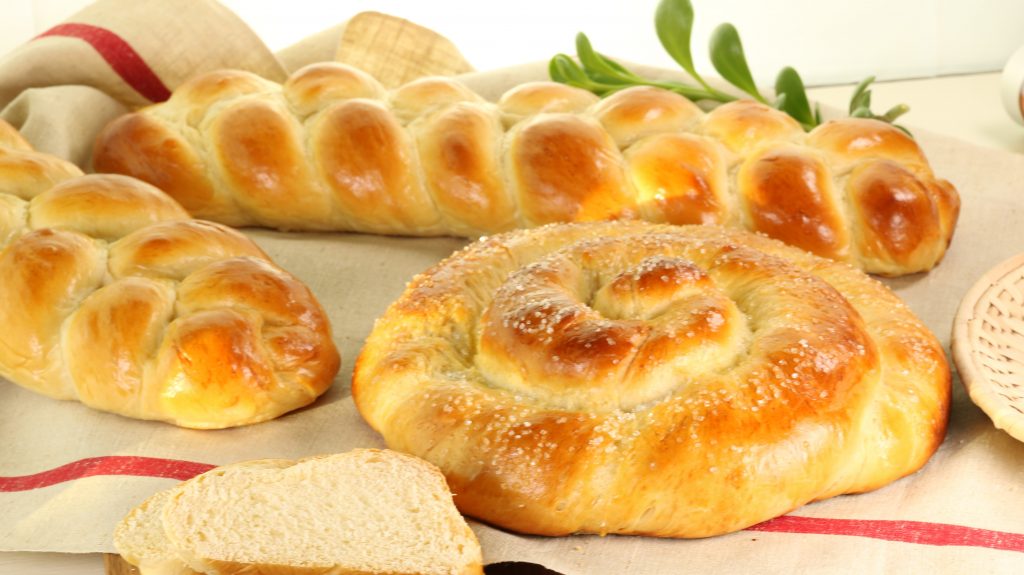
Egg wash or glaze A thoroughly combined 1 whole egg, egg yolk, or egg white and 1 tablespoon cold water or milk brushed on the unbaked surface of breads, pastries, or other baked goods just before baking to provide a rich color or gloss to the crust.
Egg white The outer, clear portion of the whole egg; comprised of protein and water. Whites stabilize baked products when beaten, add air leavening when folded into a batter, and can hold its structure as a meringue when baked. Egg whites used alone in a dough or batter also have a drying effect on the end product.
Egg yolk The yellow center portion of a whole egg, yolks are an emulsifier containing lecithin, vitamins, lutein, fat and choline; yolks add richness, tenderness, and color to baked goods.
Einkorn wheat, also Emmer Known as one of the earliest cultivated forms of wheats in the Fertile Crescent, domesticated about 10,000 years ago (8,650 BC). Einkorn is primarily eaten as bulgur or cooked kernels, not milled and baked – it lacks strong rising characteristics. Learn more: Wheat Foods Council For info on products: Ardent Mills, and Whole Grains Council

Elasticity Capable of recovering shape after stretching; developed gluten in dough is elastic.
Electrolyte Dissolved compound capable of carrying an electric current and be broken down into elemental parts.
Emmer wheat (T.dicoccum) One of the three earliest (12,000- 9,000 B.C.) wheat ancestor crops domesticated in the Near East and North Africa. It was a daily food in Pharaoh’s Egypt. Emmer is a “covered” or hulled wheat so is harder to thresh and also comparable to modern wheat in amount and nutritional quality of the protein. An advantage for emmer is that it can be grown in difficult conditions, such as in poor soils and in hilly or mountainous areas. Learn: Ancient Grains/Wheat Foods Council For information on products Ardent Mills, and Northern Crops Institute webinar.

Emulsify, emulsifier An ingredient such as an egg that, when beaten with two non-mixing ingredients like oil and vinegar, will hold them in suspension so they do not separate.
Enrich, also Enriched To improve or restore nutrients to refined grain products. (Ex: 95% of U.S. wheat flour is enriched with iron, and four B-vitamins (thiamin, niacin, riboflavin and folic acid) in amounts equal to or exceeding what is present in whole wheat flour.) Learn more: Wheat Foods Council, Whole Grains Council and Grain Foods Foundation, Enriched Grains.
Endosperm The starch and gluten-forming protein center of grain, which serves as the plant’s food supply. The endosperm is the largest portion of the grain kernel (80-85%), and is the major flour portion after the bran and germ have been removed. Learn more: What is Milling? and How Flour is Milled. North American Millers Association, Wheat Foods Council
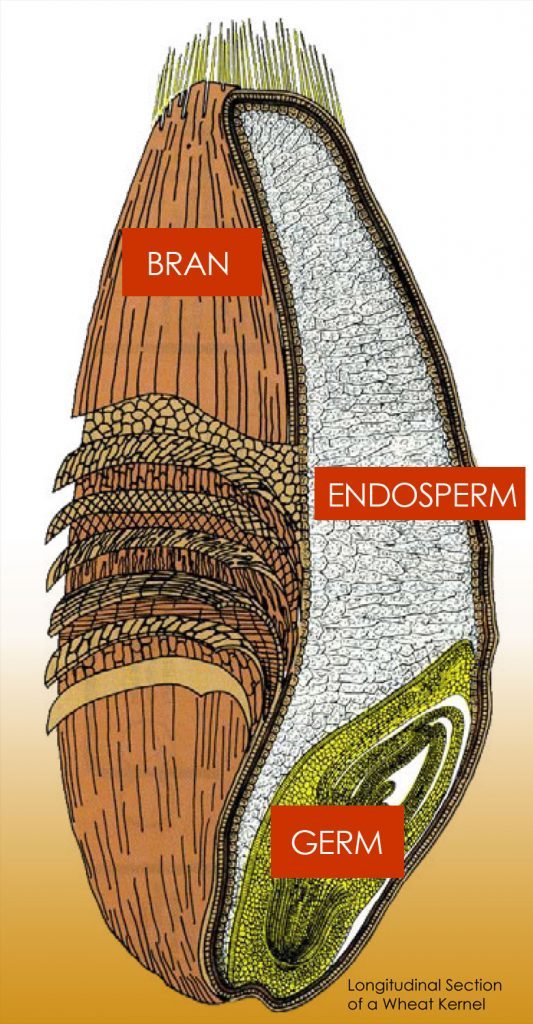
Equipment Hand or electrical tools and appliances needed to accomplish a task, craft or job.
Equivalent Equal or the same (Ex: three teaspoons is equivalent to one tablespoon).
F
Fermentation A process in bread-baking in which yeast enzymes in a dough mixture convert sugars (glucose, fructose and maltose) to bud and grow, creating carbon dioxide that expands the dough and alcohol as a by-product. Learn more: Video, Grain Craft Insights with Dave Krishock, and more Grain Craft Insights.
FIFO An efficient food storage system for less waste; means “First In, First Out,” ensuring oldest products are used first. Flaky Distinct layers of pastry or biscuit formed by using low protein flour, fat, and by not too much mixing as liquid ingredients are incorporated.
Flaky Distinct layers of pastry or biscuit formed by using low protein flour, fat, and by not too much mixing.
Flatbread Breads that are shaped and baked in thin, flat shapes such as Indigenous frybread, lavash, pita, naan, focaccia, tortilla, chapati or roti and Matzah. They may or may not be leavened and are common to many cultures around the world as a daily food staple and eating tool.
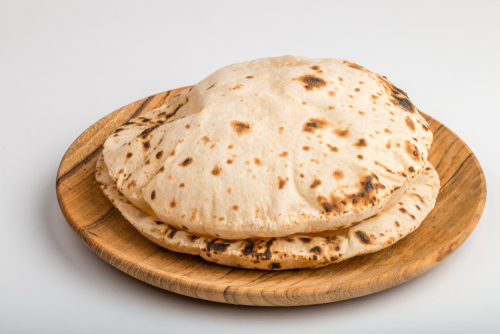
Flour (n.) The finely ground and sifted meal of any of various edible grains. Flour is a major ingredient in most baked goods with wheat flour making up 75 to 100% of the flour used to produce the desired structure, flavor and volume. Other flours with less or no gluten are also used and are made from grains (corn, barley, rye, oats, sorghum, millet, rice, triticale), seeds (amaranth, teff, quinoa, buckwheat, spelt), and legumes or vegetables (soy, lentils, peas, potatoes) and used at levels of 2% to 25%, based on the total wheat flour weight (Bakers %). Learn more: Wheat Foods Council; Grain Craft Insights Understanding Flour North American Millers Association and The Journey of Wheat from Field to Table infographic and video.
Flour (v.) To lightly dust a surface or dough with flour.
Foam 1. Moist mixture of yeast, water and possibly a pinch of sugar that is actively growing and expanding. 2. Beaten egg whites beginning to hold air, before peaks are forming.
Focaccia Italian bakers’ snack, from Latin term “focus” or hearth. Focaccia was originally baked on a stone hearth. Choose from many types; Create an Artisan Focaccia. Lesson resource: A Baker’s Dozen Labs Manual, Appendix.
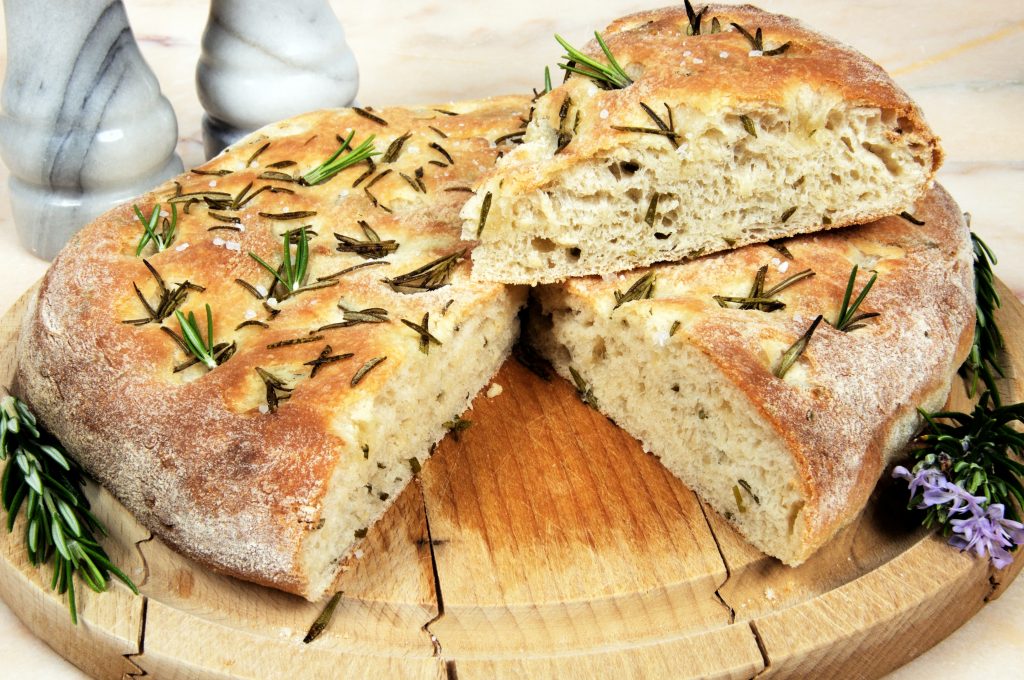
Fold To gently combine two or more ingredients or a delicate mixture into a heavier, thicker one by cutting vertically through the mixture and turning it over by sliding the mixing tool across the bottom of the bowl or pan with each turn. To combine without stirring or deflating a mixture.
Food label
Label(s) on a food product providing consumers ingredient, net weight, use-by date, allergen, nutrition and processor information. Learn more:Insert new image: Source, US FDA labeling requirements for food – FDABasics
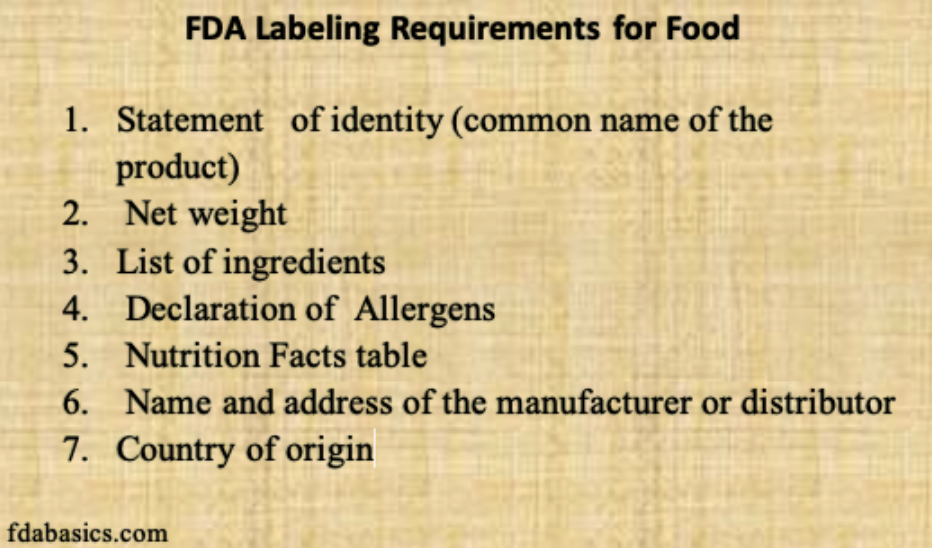
Forage – A wide search over an area in order to obtain something, especially food or provisions. Black walnuts, native to North America, are harvested as a forage crop. Learn more
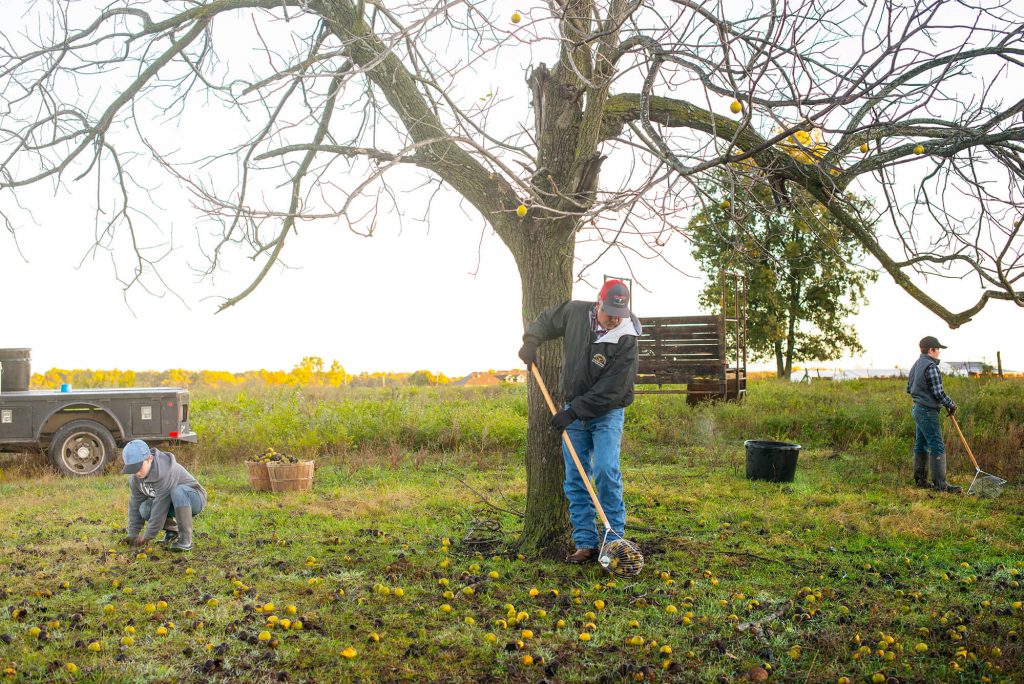
Formula The recipe or guide a home baker, culinary chef or baker uses for a product; all bakers should read formulas carefully, reading each ingredient, preparation, equipment used and order step-by-step. Alton Brown Instructs on How to read a Recipe.
Freezer burn Dehydration or drying that occurs on the surface of a frozen product. The food is safe to eat but poorer quality. To prevent freezer burn, cool product fully before wrapping to freeze; remove air; use airtight packaging.
Fructose Naturally occurring, highly sweet, fruit sugar or levulose; a monosaccharide; also found in honey, agave nectar, root vegetables; sweeter than sucrose.
Compare 3 sugars
| Fructose (fruit sugar) = a monosaccharide = made from sugar cane, sugar beets, corn; has the sweetest taste but least impact on blood sugar |
| Glucose (simple sugar) = a monosaccharide= building block of carbohydrates= one single sugar unit= less sweet = dextrose (made from corn or wheat) |
| Sucrose (table sugar) = a disaccharide = one glucose molecule + 1 fructose molecule (made from sugar cane or sugar beets, Learn Sugar STEM www.sugar.org) |
Fry To cook in heated fat; for doughnuts, fry bread, or funnel cakes, heat oil (2-3” deep) to 375 ̊ F., turn products only once; drain well. To reduce fat absorption, substitute 5% of the flour weight with defatted soy flour (1 oz. soy flour + 15 oz. wheat flour = 1 lb. flour OR 1 tablespoon per cup).
Fungi Plural for fungus; a sub-kingdom of plants including yeast, that lack chlorophyll and “bud” to reproduce. Learn more:
G
Garnish To decorate foods by adding other attractive and complementary foodstuffs to the food or serving dish.
Gelatinization (starch) The setting of the structure of a dough or batter during baking. Starches gelatinize at a temperature of 180 ̊ F. but do not caramelize until baking surface temperature reaches 300 ̊ F.
Germ Grain embryo; stem and roots sprout from the germ; 2% of grain. Rich in oil (food for the embryo) it is left in whole grain flours, but removed from enriched wheat flour and cornmeal. View
Glass Bakeware Versatile bakeware that allows you to see what is baking. Durable bakeware that doesn’t warp or stain. Glass bakeware bakes evenly and retains more moisture than metal bakeware. Available in a variety of sizes with the most popular being a 9” x 13” bake dish or 8” cake dish or 9.5” pie plate.
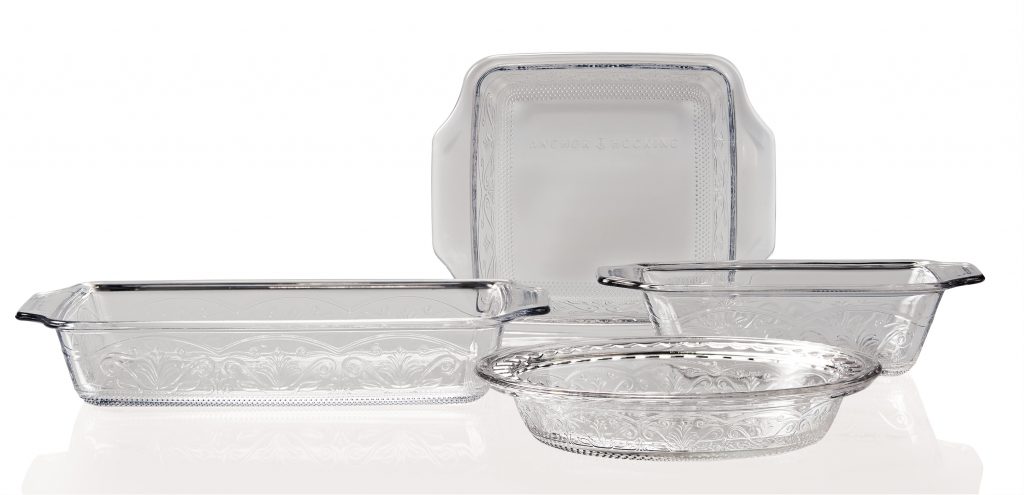
Glass Casserole Dish Round glass baking dish holds 2 quarts batter, dough or casserole mixture. Glass heats slowly, bakes evenly, and allows you to see contents while baking. Perfect for savory and sweet casseroles.
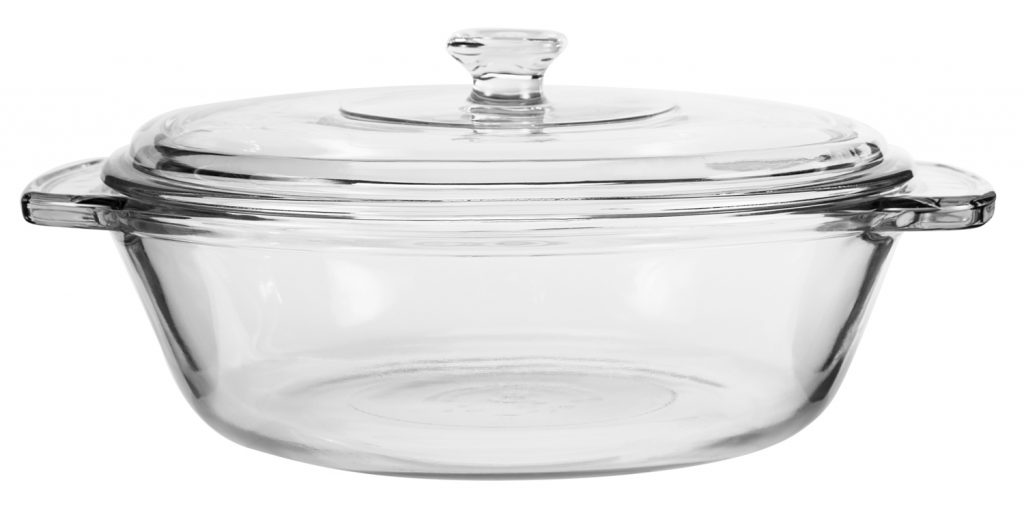
Glass Loaf Dish Rectangle shaped glass dish that is typically 5” x 9”. Glass heats slowly, bakes evenly, and allows you to see recipe while baking. Perfect for breads, meatloaf, pound cakes and more.
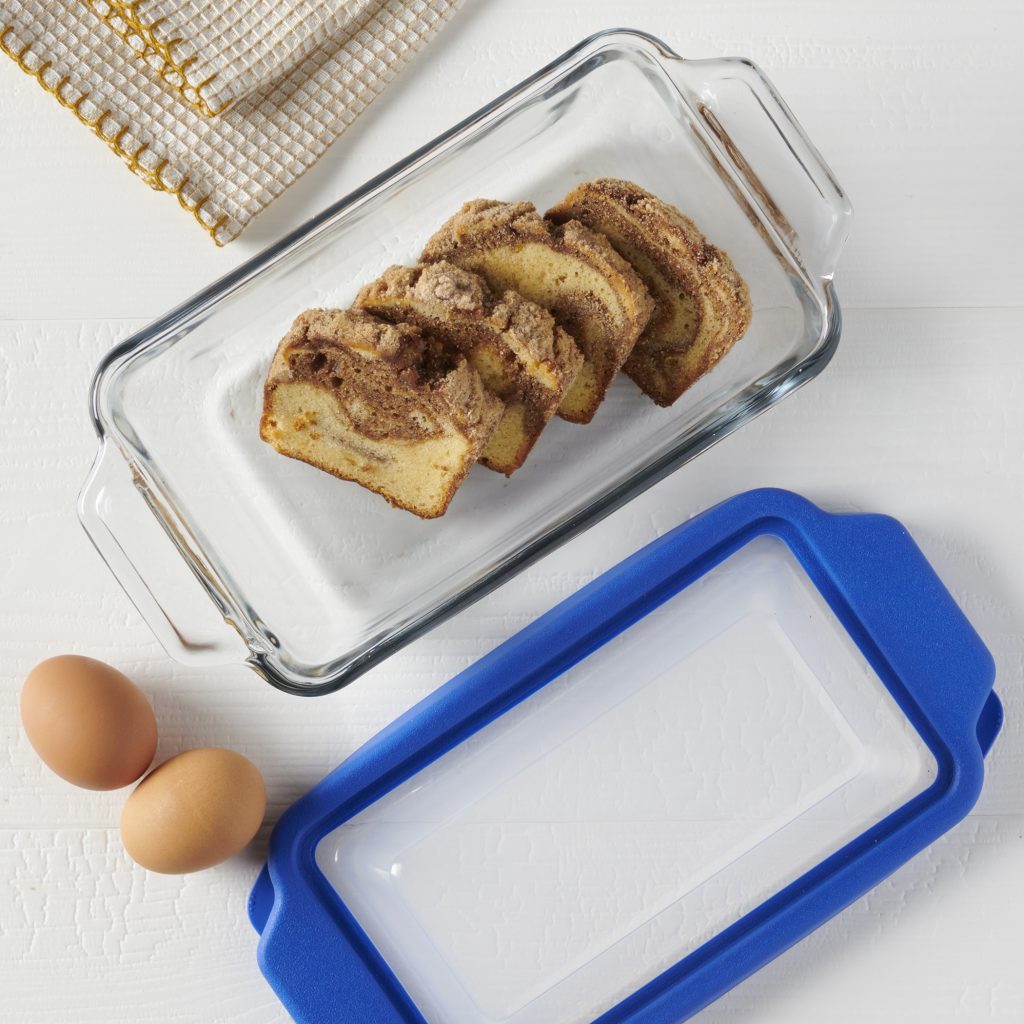
Glucose Also dextroglucose called dextrose; commonly found in grapes, corn starch and honey and is about 30% as sweet as sucrose (sugar). A monosaccharide= building block of carbohydrates
Gluten The elastic, expandable structure in a dough or batter capable of trapping gas, expanding and when baked becoming part of the structure of baked products. Wheat flour simple proteins (peptides), glutenin and gliadin, combine with water when stirred, mixed and kneaded to align and form gluten’s long elastic structure. Gluten containing grains are wheat, durum semolina, rye, spelt, kamut, einkorn, emmer, farro and barley. Download Much Ado About Gluten Infographic.
Gluten-free Grains or grain-based foods that do not contain gluten or the components of gluten, the peptides glutenin and gliadin. National Celiac Association GF King Arthur Baking Guide, and How to Substitute GF Bread Flour. GF Yeast Bread Baking, GF Vanilla, and HBA Resource: Why Bake? A Baker’s Dozen Lab, Baking for Special Needs and Whole Grain Baking Tips.
Gourmet Highest quality food or ingredients, skillfully prepared and artfully presented.
Grade A large egg Grade A means the egg will have a thick, white, round, well-centered yolk, small air cell and clean, uncracked shell. Large eggs are typically used in baking; weighing 1.75 oz/50g, without shell.
Graham Stone-ground or whole wheat flour made from either red or white, hard, soft or a blend of both wheat classes. All whole wheat flour is made from the whole kernal of wheat and is produced by either grinding the whole wheat kernel or recombining the white flour, germ and bran to make a whole wheat flour. Coarseness varies, but nutritional value differs very little. “Graham” refers to an early proponent of whole grain foods, Rev. Sylvester Graham. Learn more: North American Millers’ Association,Types of Wheat Flour, and Whole Grain Baking 101.
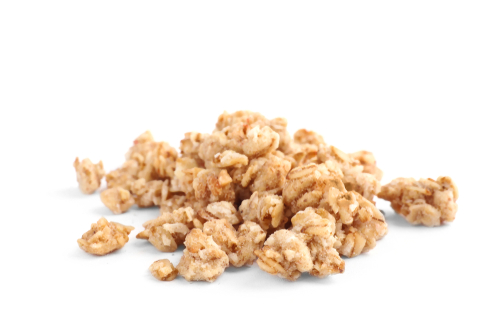
Granola Cereal mixture of toasted rolled oats, barley or other grains, plus dried fruits, seeds, nuts and sweeteners.
Grain 1. As in cereal grain; edible seeds or grain produced by plants in the grass family. The most popular cereal grains are barley, corn, millet, oats, quinoa, rice, rye, sorghum, triticale, wheat and wild rice. Learn more: Grains Foods Foundation, Wheat Foods Council, Oldways Whole Grain Counsel, HBA Members
2. The appearance of the crumb of baked products as determined by the number and size of air pockets, the cell structure, and the thickness of cell walls.
Grate To reduce a food into small bits by rubbing it against the sharp teeth of a grating utensil.
Grease Rub oil, shortening, butter or fat over surface of cooking utensil or on a food. May also use a lecithin based, non- fat cooking spray, unless bakeware does not recommend it.
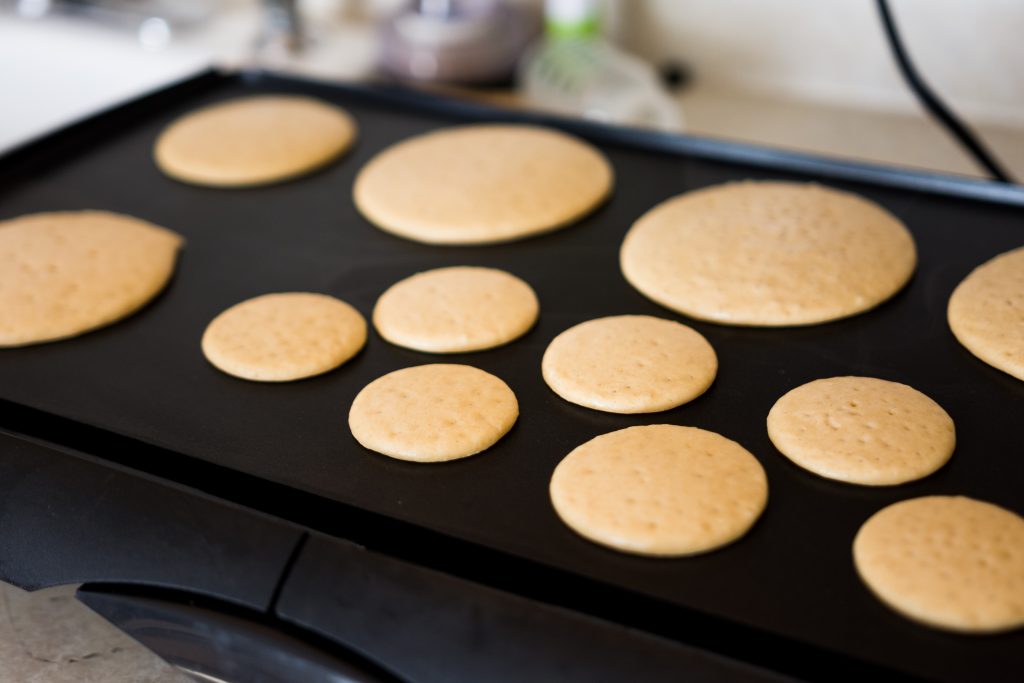
Griddle Heavy-weight flat, rimless pan for baking flatbreads using as little fat as possible; flipping is done halfway through baking; may be electric or set over heat.
H
Halite Rock salt deposits from which salt is mined. (See Lab 10)
Hard wheat Wheat classes including hard red winter, hard red spring, hard white winter, hard white spring and durum wheat; hard wheat classes provide the quantity and quality of protein bakers desire for bagels, buns, loaves, pasta (durum) and more. Six Classes of Wheat and U.S. Wheat Map of 6 Classes
Hearth bread Yeast bread baked in round, oval or free form on hot, flat baking surfaces in an oven. See North Dakota Hearth Bread; Everyday Whole Grain Bread; Quick and Easy 2-Hour Artisan Style Peasant Hearth Bread; Country Loaf and Pilgrim Hearth Bread.
High-altitude baking Adjustments to liquids, leavening agents, sugar, and oven temperature are needed at altitudes over 3,500 feet. Colorado State University notes, “Do not assume that your sea level recipe will fail. Try it first. It may need little or no modification.”
Decreased pressure affects food preparation in two ways:
- Water and other liquids evaporate faster and boil at lower temperatures.
- Leavening gases in breads and cakes expand more quickly.
Example: Approximate boiling temperatures of water at various altitudes

High Fructose Corn Syrup (HFCS) Primarily used in commercial beverages and foods, HFCS is not the same as corn syrup used in home cooking and baking. HFCS is made when corn starch is converted to dextrose-rich syrup; using isomerization, the dextrose-rich corn syrups are further processed to create fructose. The fructose is then blended with dextrose syrup to produce the commercial HFCS with 42 to 95% fructose. Fructose is 130 to 180% sweeter than sugar.
Holding To keep products in the best environment for quality serving or long-term storage. Learn: Fight BAC www.fightbac.org guides holding hot or cold foods. Kansas State U Extension offers Food Storage guide guides baked goods, ingredients and other room temperature holding temperatures and times.
Honey A thick, sweet liquid produced by bees from flower nectar. Color and flavor vary due to the nectar the bees find available. Honey develops golden crust color and holds moisture in baked goods. It may be substituted one for one with less than 1⁄2 cup sugar in yeast bread recipes; in quick breads, cookies and cakes calling for more than 1⁄2 cup sugar, adjustments to the liquid or flour will be needed. Emergency substitutions for 1 cup honey include:
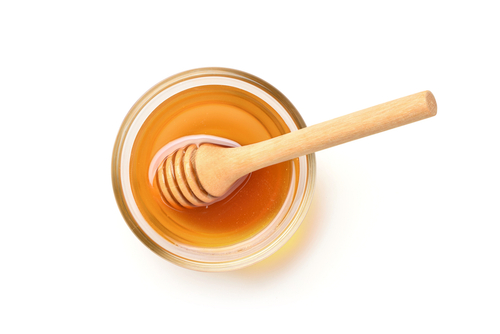
1 1/4 cups granulated sugar plus 1/4 cup liquid (use whatever liquid is called for in the recipe).
1/2 cup granulated sugar and 3/4 cup maple syrup, light or dark corn syrup or light molasses.
Honey butter Creamy blend of 1/2 cup butter (4 oz) and 1/2 cup honey beaten until smooth and spreadable.
Humectant A moistening ingredient; ingredient that promotes retaining moistness in a baked product.
Humidity The amount of moisture in the air; in baking, the percent humidity needed for proofing or baking bread.
Hydrate To moisten or combine with water or liquids.
I
Ingredient Any part of a mixture.
Ingredient list Ingredients making up a food and appearing on a food label in order, most to least.
Intermediate proof Short time (10 to 30 minutes) between punching, dividing, rounding and molding the dough –“resting or bench time.” Important for dough to be kept covered or
in a proof box, warm and away from drafts (80 to 90° F. at 75 to 80% humidity) – dough “relaxes” and becomes more manageable.
Instant-read thermometer Stainless-steel probe thermometer indicating the temperature of a liquid, mixture, dough, or meat almost instantly. It is an excellent baker’s tool for yeast bread-baking. Learn more about quality baking thermometers and Quality Baking Temperatures.
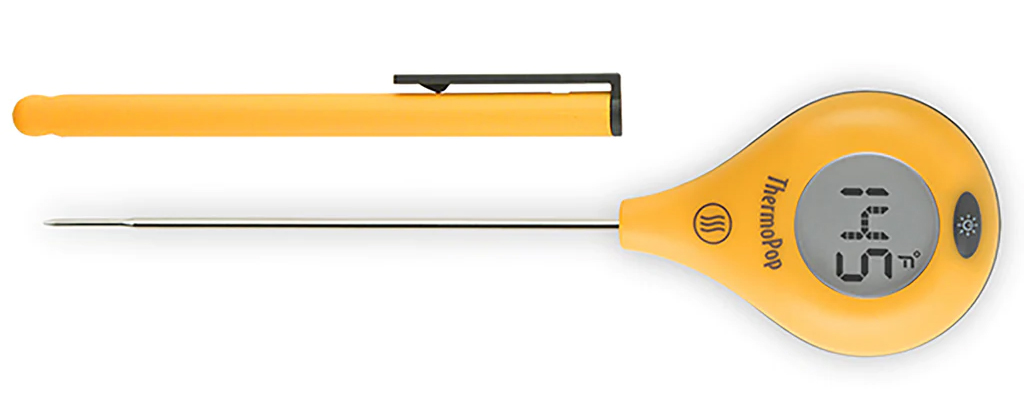
Insulated bakeware Metal bakeware constructed of two layers separated by an insulating cushion of air. Benefits include even baking and consistent results with less bottom crust browning. Oven temperature for cake and brownie mixes should be set 25° F. higher. For all other baked goods, use the recommended temperatures, but longer bake times may be needed.
Invert sugar Sugar syrup exposed to a small amount of acid and heated to break sucrose into glucose and fructose to reduce the size of the crystals. Invert sugar is used for fondant icings for cakes.
Iodized salt Table salt with added sodium iodide to help prevent hypothyroidism in regions low in natural iodine. Many bread bakers prefer the use of non-iodized salt (pizza crusts and flat breads) or Kosher salt. Learn more: Baker Bettie, The Importance of salt in Baking.
J
Jelly-roll pan Rectangular baking pan with a 1-inch edge, usually 18 x 13 inches, commercially known as a “half-sheet pan.” In home baking, sizes vary; a common size listed in recipes is 15 ½-inch x 10 ½ -inch x 1-inch. It is preferred for baking sheet cakes, sponge cakes, or bars. (It gets its name because the sponge cake for a jelly roll cake is baked in this pan.) View Jelly Roll Cake demonstrated.
Juice (v). To cut and squeeze or press a fruit to obtain the juice for a batter, dough, frosting or drizzle.
K
Knead also kneading.
Kneading To mix dough using a pressing and folding motion, turning and folding the dough onto itself until gluten strands form and the dough is smooth and elastic. View how to knead, and Red Star Yeast
Kitchen The place in a home where lives converge, food is prepared, people are sustained and flourish.
Kosher salt Kosher additive-free, coarse-grained salt, preferred by some bakers and Jewish Kosher food processors; 1 tsp table salt (6g) = 1 ¼ tsp (6g) Kosher salt
L
Lab Short for laboratory; a room to work or test.
Lactose Milk sugar; the sugar naturally occurring in milk.
Lean dough Dough prepared with little or no fat, sugar, or milk. Check out this handy resource from Baker Bettie!
Leaven (n.) also leavening, (v.) include ingredient or mechanical action to leaven or include air space or CO gas in a batter or dough.
Leavening Ingredients used in baked goods to lighten the texture, develop flavor, produce distinctive cell structure and increase volume. Leavening agents include heat and moisture (steam), beaten eggs or egg whites, baking soda, baking powder, cream of tartar, and yeast. Historical terms for leavening: Latin = levre = to raise; early American bakers called this ingredient a “lifter;” French = levain (nearly synonymous with sourdough starter)
Level Straight–edged knife or spatula used to scrape across a dry measuring cup in which flour or other dry ingredient is heaped.
Lifter An old-fashioned term for the leavening or “lifter” in a batter or dough.
Liquid A source of fluid or moisture in a batter, dough or mixture. Fresh fruits and vegetables (chopped, pureed, grated) can also provide a portion of the liquids.
Liquid measure Clear cup or beaker with a lip for pouring, marked with lines to measure liquid ingredients in ounces, milliliters, and 1/8, 1/4, 1/3, 1/2, 2/3, 3/4 and 1 cup or more. Place measuring cup on a flat surface and add liquid to line for amount needed. View Anchor Hocking and HBA Resource Level Headed Measurement.
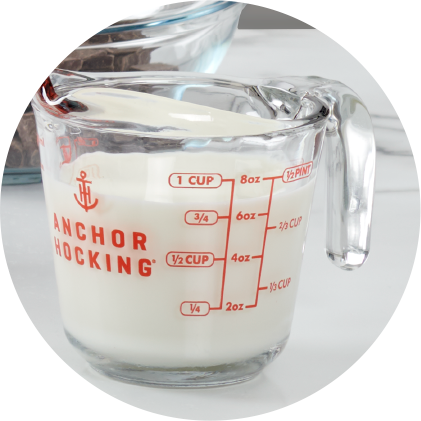
Loaf Portion of bread dough baked in one piece or form.
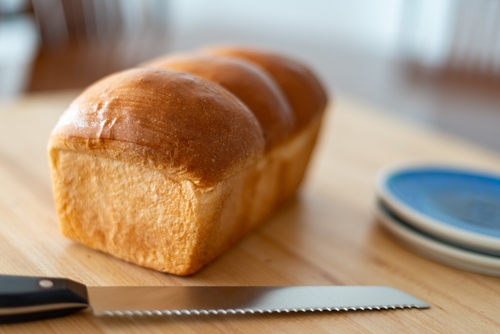
Low fat Less than 3 g fat per serving or reference amount.
Low sodium Food will be 140 mg or less per serving.
M
Make-up After fermentation(s), shaping the dough into loaves or other shapes. Includes scaling (dividing), rounding, intermediate proof, molding and panning the dough pieces.
Mash To break up into finer, smoother pieces by pressing with back of a spoon, a masher or ricer.
Margarine Developed as a butter substitute in the late 1800s, margarine is 80 percent vegetable oil hydrogenated
to hold a solid form. Remaining 20 percent is liquids. May be salted or unsalted. True margarine can substitute for butter 1:1, but spreads (whipped, in tubs or sticks) cannot as they contain more, and variable amounts of liquid, more information here. Land O’lakes
Marshmallow Crème A confectionery spread that tastes like marshmallow. Often made with corn syrup, sugar, and egg whites. It is used as a spread, or an ingredient in baked goods. Make a Homemade version, Marshmallow Fluff View how to make
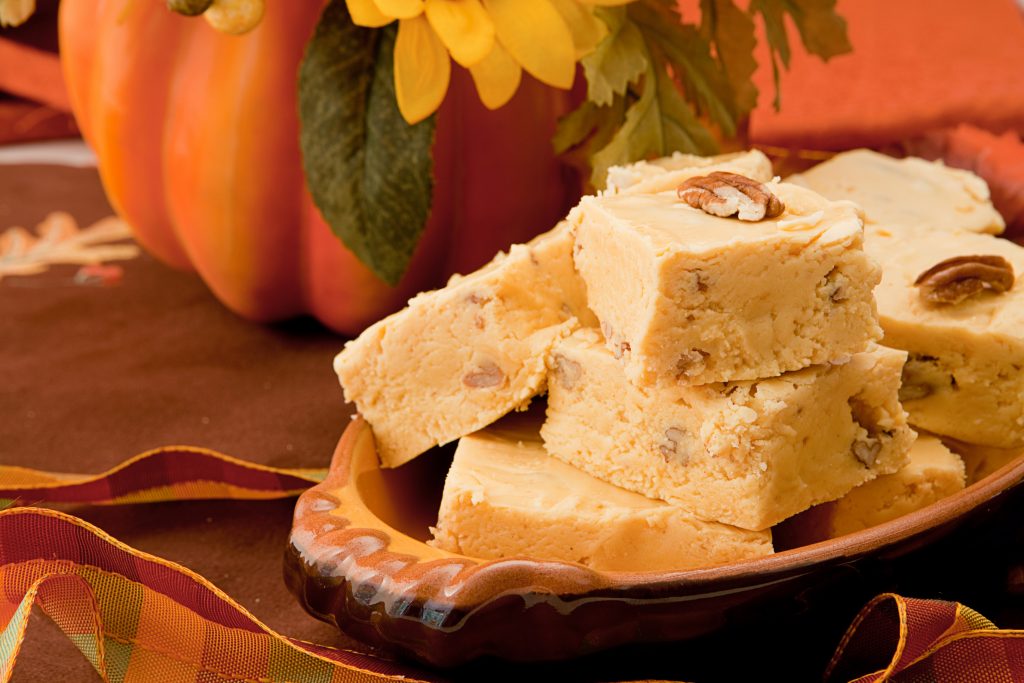
Marzipan A soft, pliable paste, made by mixing blanched, ground almonds with sugar and corn syrup. It is often used to sculpt shapes and figures, or as a fondant replacement, because it is easy to roll out and stays moist. It is sweet and candy-like in taste, and may be referred to as almond candy dough.
Fondant is made from sugar and gelatin and will dry out more easily since marzipan includes ground almonds, which act as a flour and the fat keeps marzipan easy to roll and provides delicious almond flavor. Learn more including how to make it!
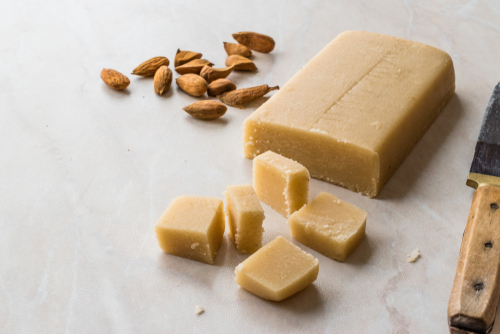
Meal Grain or seeds milled or ground more coarsely than flour. Examples: Cornmeal, oatmeal, flaxmeal
Measuring cups and spoons Containers or spoons that come in graduated sizes (1/8, ¼, 1/3, ½ , 2/3, ¾ and 1 cup dry or liquid measures) used to accurately measure dry or liquid ingredients when cooking or baking. It is best to measure dry ingredients with dry measuring cups and liquids with liquid measuring cups. Activity worksheet, Measure UP?!.
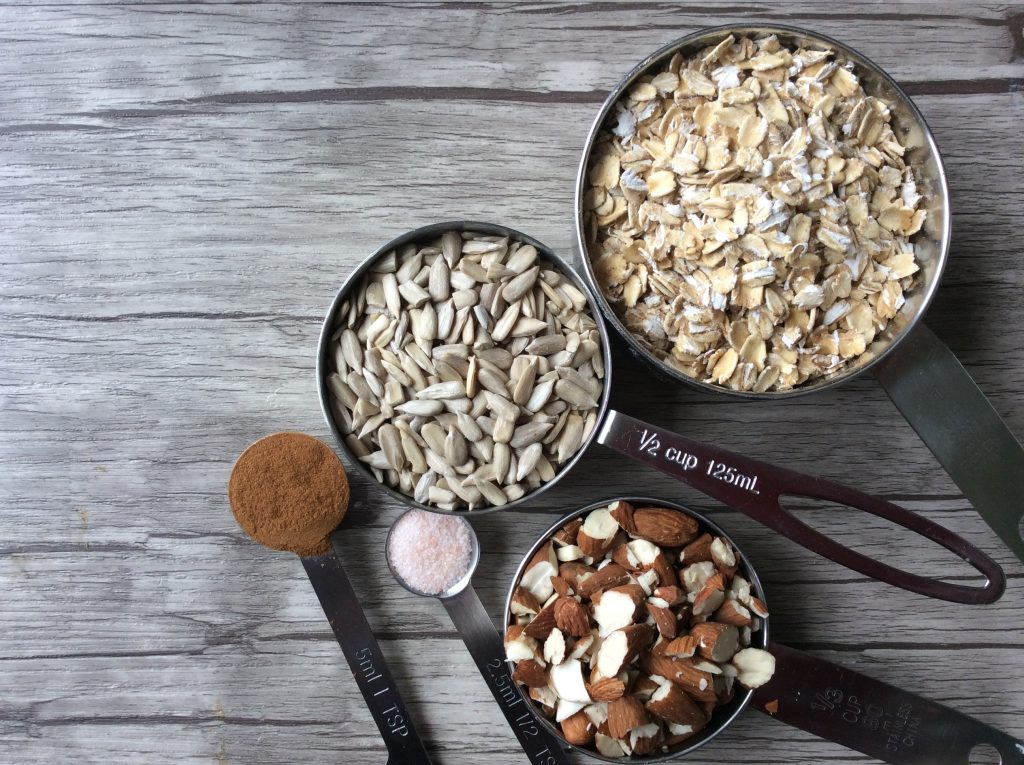
Melt Heating a solid food such as butter until it is liquid.
Meringue Stiffly beaten egg white and granulated sugar that may be soft or baked hard. Tips C&H Sugar, How to make the perfect Meringue topping for pies
Melting point The temperature at which a fat or chocolate will begin changing from a solid to a liquid state. Butter melts at ~ 82° F/27°C) and sugar melts at a temperature of 366°F (185.5°C).
Milk chocolate Sweetened chocolate (at least 10 percent chocolate liquor) with additional milk solids (at least 12 percent).
Mince To cut or chop into very small pieces.
Mill Grain food processing facility producing grain food products such as flour, meal, germ, bran, rolled grains, bulgur, baking mixes, cereals and a variety of other grain-based products. Learn more: What is Milling?
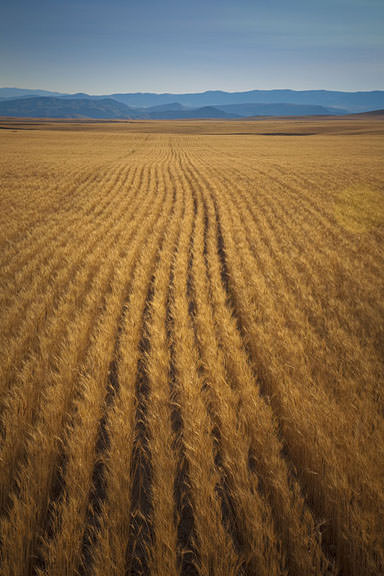
Miller Professional engaged in producing food products and ingredients from a variety of grains, seeds and legumes for use in baking, foods and animal feeds. See Milling Science, Kansas State U.
Millet Finely ground flour from whole millet; a starchy, low- gluten flour with texture similar to rice flour. Millet flour is naturally gluten-free, and a mild flavor, ideal for both sweet and savory gluten-free baked goods. Like other gluten-free flours, millet flour often requires a binder (such as xanthan gum or cornstarch) to add “structure”. Learn more: Ardent Mills, About Millet, Baking with Millet
Mineral Solid substance formed in the earth that is not animal or vegetable (Ex: salt, iron) Salt Mines; Under Kansas
Mise en place Pronounced mee zon plahs)— read recipe/ formula, have all ingredients and equipment in place before preparing a recipe. All about mis en place.
Mix To combine two ingredients by stirring or in a way that makes two or more foods appear as one.
Mixing With yeast dough, refers to four stages—pick-up period, preliminary development, elasticity development, and final gluten development. Mixing tips from GrainCraft.
Mixing Stirring, usually with a spoon, whisk or beater, until no individual ingredients can be seen or identified.
Moisten Brush, stir or sprinkle with liquid.
Mold A fuzzy growth of fungus on a bread, vegetables, fruit or damp surface; indicates decay or spoilage.
Molding (v) Follows intermediate proof—dough must be relaxed—final shaping step where dough is flattened (sheeted) or shaped for loaves, braids, rolls, twists.
Muffin Small, cake-like sweet or savory leavened breads.
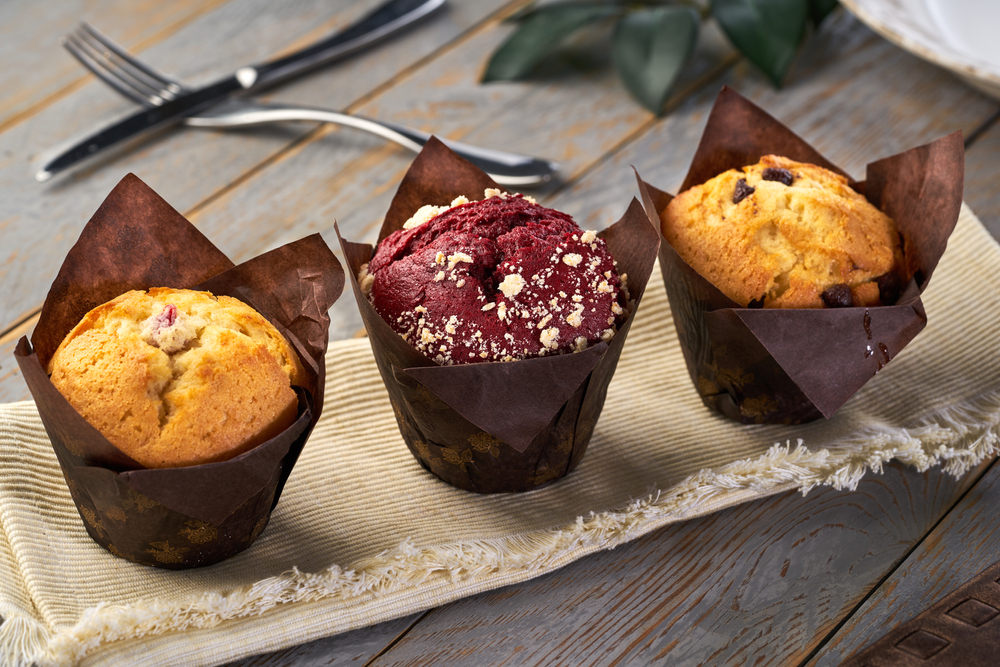
Muffin mixing method Use of two bowls, mixing liquid and dry ingredients separately; stirring to combine is done quickly and with as few stirs as possible to prevent gluten formation. View The Muffin Mixing Method, Baker Bettie and cornbread at: DIY Baking Channel
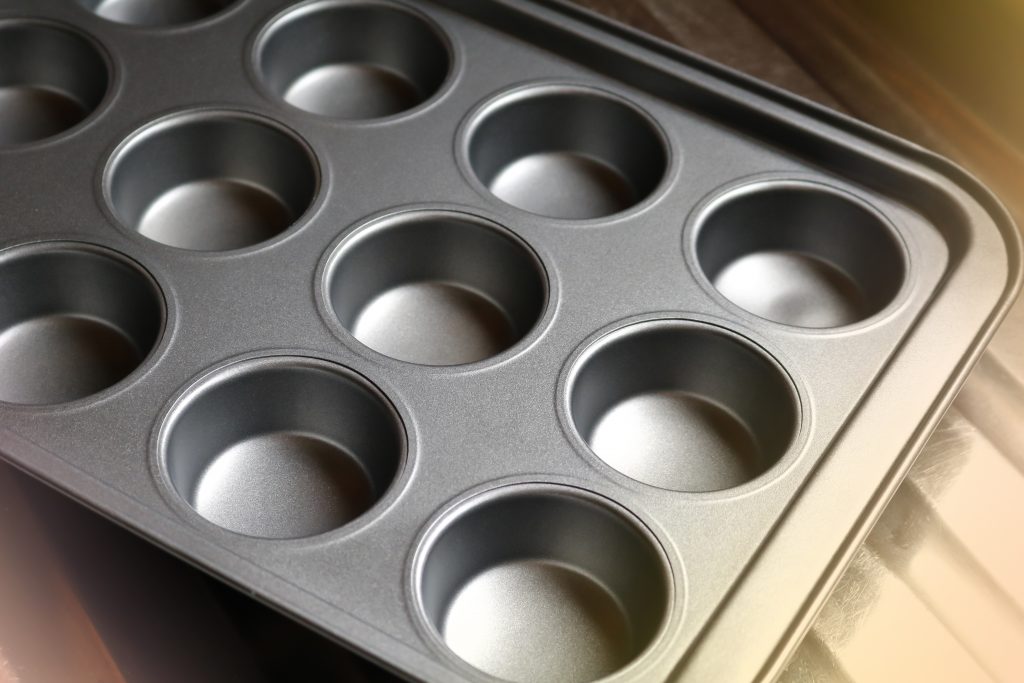
Muffin pans Muffin pans come in many sizes and shapes, even “muffin tops.” The 6 or 12-cup standard muffin pans measure 21⁄2 inches across the cup. For best results, always line with paper liners or grease just the bottoms and lower thirds of the muffin cups. Mini-muffin tins, also called “tea muffins,” are popular in 12-cup and 24-cup pan sizes.
Multi-grain (adj.) Flour, meal, cereal or any grain food (refined or whole grain) using two or more grains. Formulas, ingredients: Ardent Mills, Red Star Yeast whole and multi-grain breads, Whole Grain Baking 101 and Customizable Quick Breads.
Muscovado sugar See Barbados Sugar. Another type of unrefined sugar, darkly flavored from sugarcane juice left in during the production process. It tends to be sticky and can be used just like brown sugar. Learn more: Sugar Association
N
Native An original or indigenous inhabitant to a particular locality. Example: the black walnut is a nut that is native to North America. Learn more
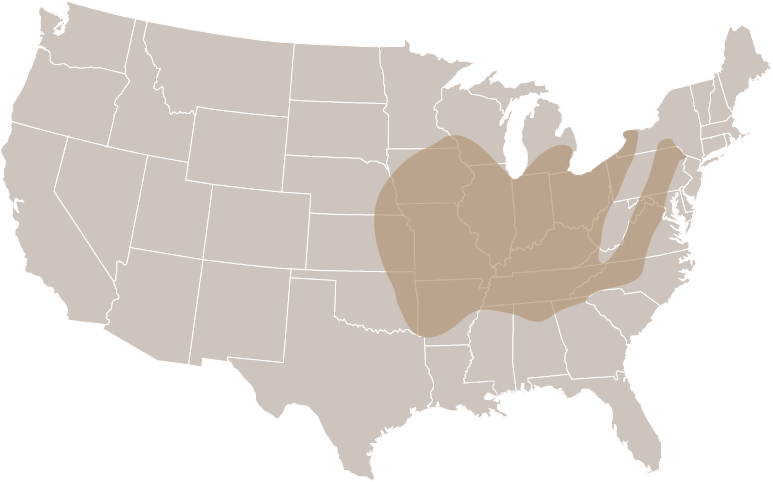
Net weight The weight of the contents in a package, excluding the packaging weight.
Nibs Cocoa nibs are simply roasted cocoa beans separated from their husks and broken into small bits; may be used in cookies or as a topping in place of nuts. See Utah State U. Bean to Bar Chocolate Factory.
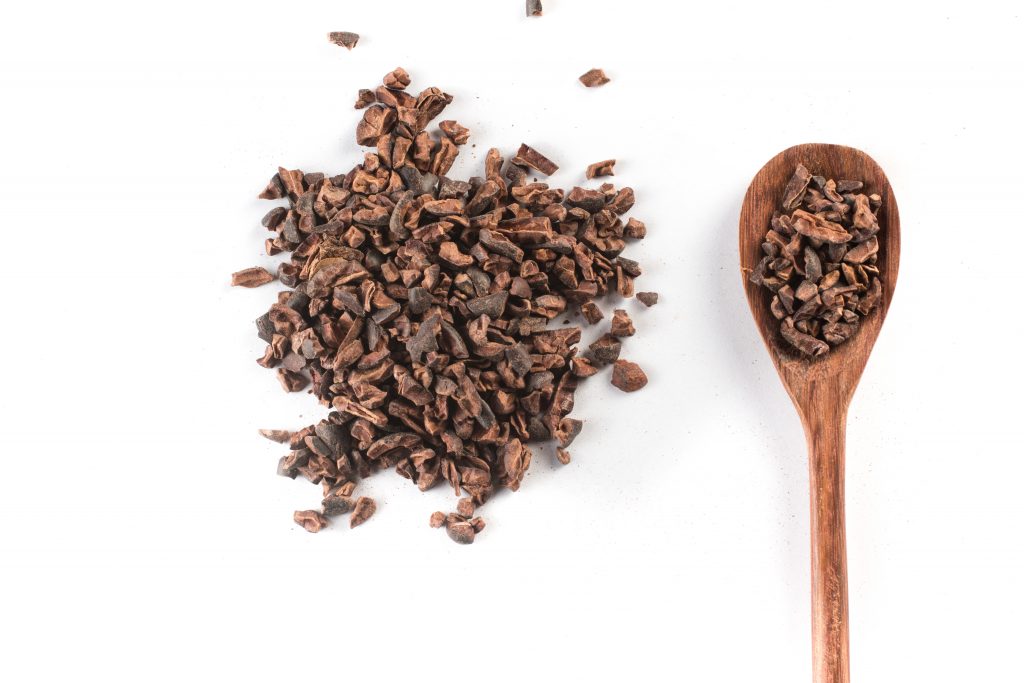
No-knead This home-baking method refers to yeast breads that require no kneading. They also are called “batter breads.” See America’s Favorite No Knead Batter Bread and View America’s Favorite No Knead Bread video.
Nonstick Coating which is either applied through a high temperature process called coil-coating on metal before a pan is formed, or spray coated on a pan. Look for packaging instructions regarding the lowering of baking time or temperature for best results.
Nut flour Nut meats, toasted or untoasted, that are finely ground for pastry crusts, breads, cakes, and cookies.
Nutrition Facts A box on the food label offering serving size and basic nutrition information for a food ingredient, recipe or product. Learn about Nutrition Facts Label and How to Understand
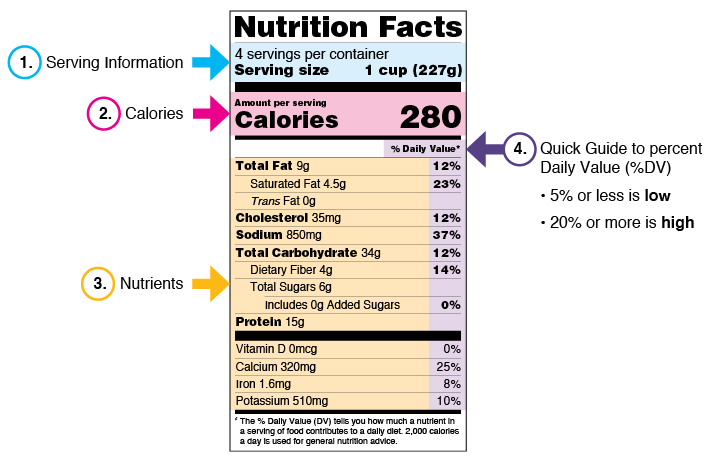
Nuts The dry fruit of trees, legumes, or seeds; an edible kernel encased in a hard, dry shell. Rich in nutrients, monounsaturated fat, flavor, and texture, nuts provide sensory appeal to baked goods especially when toasted. Popular nuts used in baking include almonds, pecans, black walnuts and walnuts. Here’s how to toast nuts, All about native black walnuts, Baking recipes using Black Walnuts
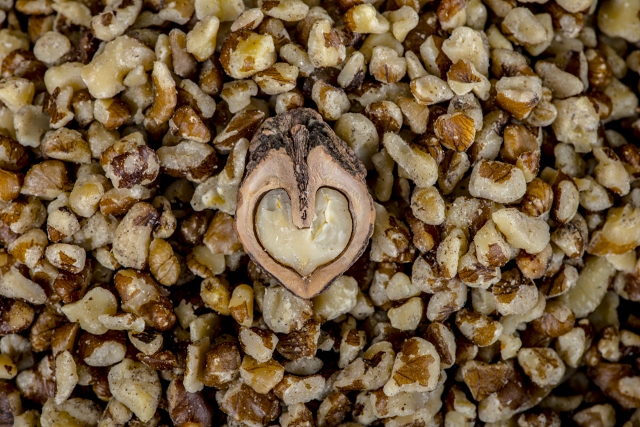
O
Oats The second most popular whole grain in the U.S.; oats are never refined and are whole grain in all their forms except Oat Bran. Oats are toasted, hulled, cleaned, and cooked whole (groats), or the groats may be steamed, steel-cut, or flattened (rolled). Rolled oats, or old-fashioned oats, may be cut further, making them quick-cooking; all forms are whole grain. Rolled, old-fashioned or quick oats are just a size difference and may be used interchangeably in baking. Instant oats may not be used interchangeably in baking due to finer cutting and further cooking of the starch; they are also often sweetened and flavored. Oat flour is made by grinding groats or rolled oats into flour. Learn more: North American Millers Association and Whole Grains Council on oats. Images courtesy of Whole Grains Council with Grain Millers
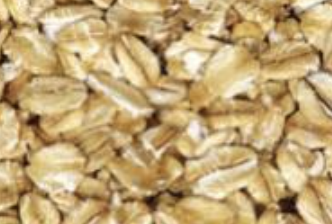
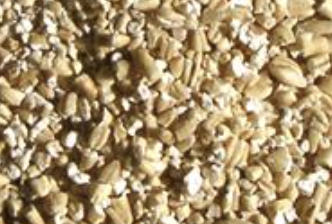
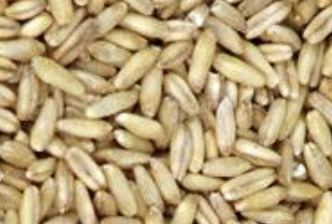
Rolled Oats
Steel Cut Oats
Oat Groats
Oat bran The outer layers of the oat kernel that are particularly high in soluble fiber; good added to baked goods.
Oils Fats used in baking come from two sources–plant or animal. Vegetable oils are plant-based and liquid at room temperature. Home cooking and baking products labeled vegetable oil are most commonly and affordably sourced from soybeans and canola. Other plant-based oils are labeled specifically to its source: corn, peanut, walnut, palm, grape seed, coconut, olive, safflower and sunflower. No oil derived from a plant contains cholesterol, but vary in amounts of poly- and mono-unsaturates and saturated fat. Soybean oil is a polyunsaturated fat. Coconut oil will be semi-solid at room temperature and has different baking properties. Learn more: How to Choose Healthy Cooking and Baking Oils.
Old dough Yeast dough that is overproofed; dough may have tripled in volume and fallen.
Oven An enclosed area that supplies heat and air flow to cook food. Conventional/thermal ovens use electric elements or gas burners to bake, roast, or broil; convection ovens use electric elements or gas burners plus the addition of a fan to circulate heated air around the food. Most electric ovens have controls which cycle the lower and upper elements for consistent temperatures. Ovens may also use halogen lights and/or microwave energy to increase the cooking speed. Ovens may vary in width from 20 to 36 inches and may be free-standing, slide-in, drop-in, or a wall oven. Pre-heating before loading product to bake, and re-heating ovens between re-loading is important to success. See Baking Temperatures Preheat Your Oven and a video.

Oven mitt Thickly padded or heat-insulated large mittens worn to load or remove baked goods from oven. Food safety: wash mitts regularly. Baker safety: discard mitts with holes; never use damp or wet oven mitt.
Oven-spring When yeast breads first begin to bake, they will have a “growth spurt” until the yeast dies (140° F.) and the starch gelatinizes (180° F.) to hold the final size and shape.
Overproofing Allowing dough to proof beyond a full doubling of size; if dough actually proofs and falls, the product will be very open-grained, low-volume, have a crumbly texture, undesirable flavor, pale crust, strong aroma and poor keeping quality.
P
Packed Refers to measuring brown sugars. Spoon brown sugar into dry measuring cup and press down until firmly packed, overfilling slightly, then leveling. When dumped out, packed brown sugar should hold its shape (as when making sand castles).
Pan Utensil used to hold dough or batter—may be rectangular, flat or round. Best surface for baking is heavy gauge steel and/ or aluminum; glass baking pans require adjusted oven temperatures—reduce about 25° F. and provides less doming for cake layers and a less-soggy browned bottom crust for pies and breads. Learn more about baking in glass and a guide to baking pan substitutions.
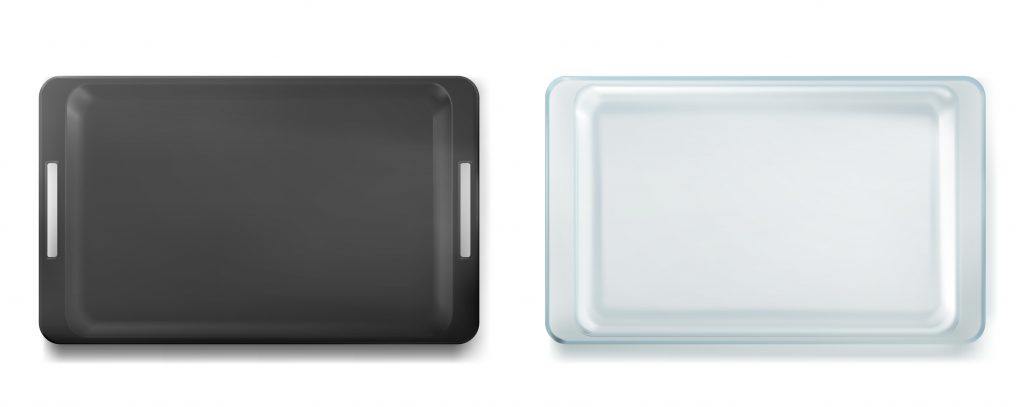
Pancake One of humans’ oldest bread forms, hundreds of types are shared in cultures; batter may be thick or thin, baked on a very hot surface; for breakfast, lunch, dinner or a snack. (Ex: crepes, blinis, hotcakes, flapjacks). Recipes: HomeBaking.org
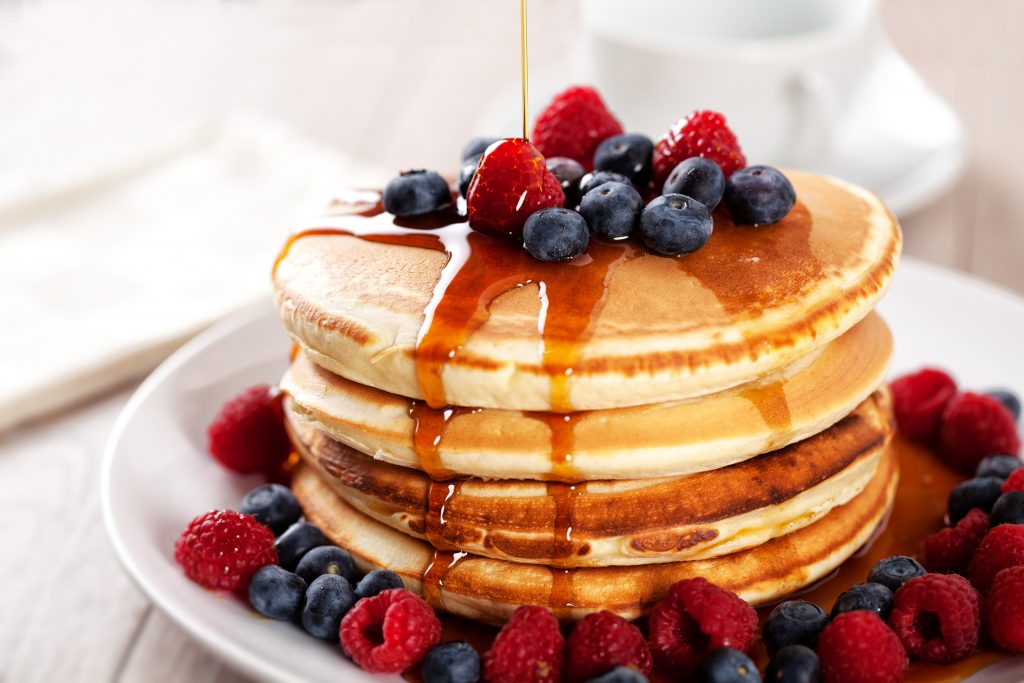
Panning Placing dough in or on prepared pans. Pans may be lined with parchment, oiled, sprayed with pan-release, or sprinkled with meal. Make sure the pan is the correct size for the amount of batter or dough. NOTE: Some baking pans should not be sprayed with lecithin cooking sprays—check manufacturer’s care guidelines. See Pan.
Pantry Storage space near kitchen for food, pans, ingredients and equipment.
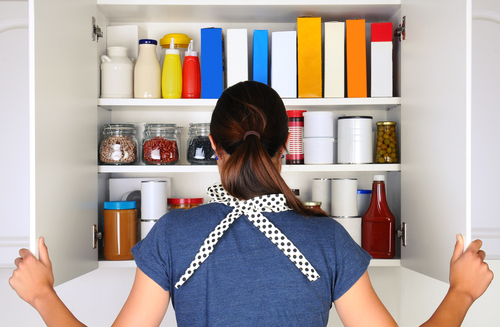
Parchment paper Grease and moisture-resistant paper used in baking to line pans; replaces greasing or spraying pans. Products may be rolled, shaped or distributed directly on the paper. Great for making disposable pastry bags and baguette baker’s couche (pronounced “KOOSH”). Source: King Arthur Baking
Pare To remove the outer covering or skin of fruit or vegetables with a small knife or peeler.
Partially set To refrigerate a gelatin mixture until it thickens to the consistency of unbeaten egg whites.
Pastry blender Hand-held U-shaped tool with 5 or 6 sturdy parallel wires or blades (preferred style) used to “cut” cold butter or fat into smaller pieces into a flour mixture without melting or smearing the butter or fat or overworking it with the flour. View cutting in
Pastry cream is a filling made from the same ingredients as crème anglaise (egg yolks, sugar, milk, vanilla), but also includes thickeners such as cornstarch.
Pastry flour Fine-textured flour produced from soft red or white wheat and 8-9% protein (~2% points lower than cake flour); may be bleached, unbleached, or whole wheat. It is ideal for pie crusts, scones and other delicate pastries. Soft red and white wheat pastry flour sources: Ardent Mills, Grain Craft, Homegrown Family Foods and Sunflour Learn more: Flour 101
Peel Rimless, lightweight board, may have a long handle; used to transfer proofed bread to hot baking stone in oven.
Percentage Part or portion of a whole; (A) Baker’s percentage = the percent one ingredient is of the total flour weight—Ex: Sugar is 5%. See Baker’s Percent. (B) The number of consumers in a consuming group who feel or think something—Ex: 5 out of 100 (5%) think the product is too sweet. See: Baker’s Percent entry, Consumer Research
Pie A sweet or savory dish made with one or two crusts and filling (pudding, fruit, meat or vegetables). Resource, see lesson, power point, worksheets, recipes.
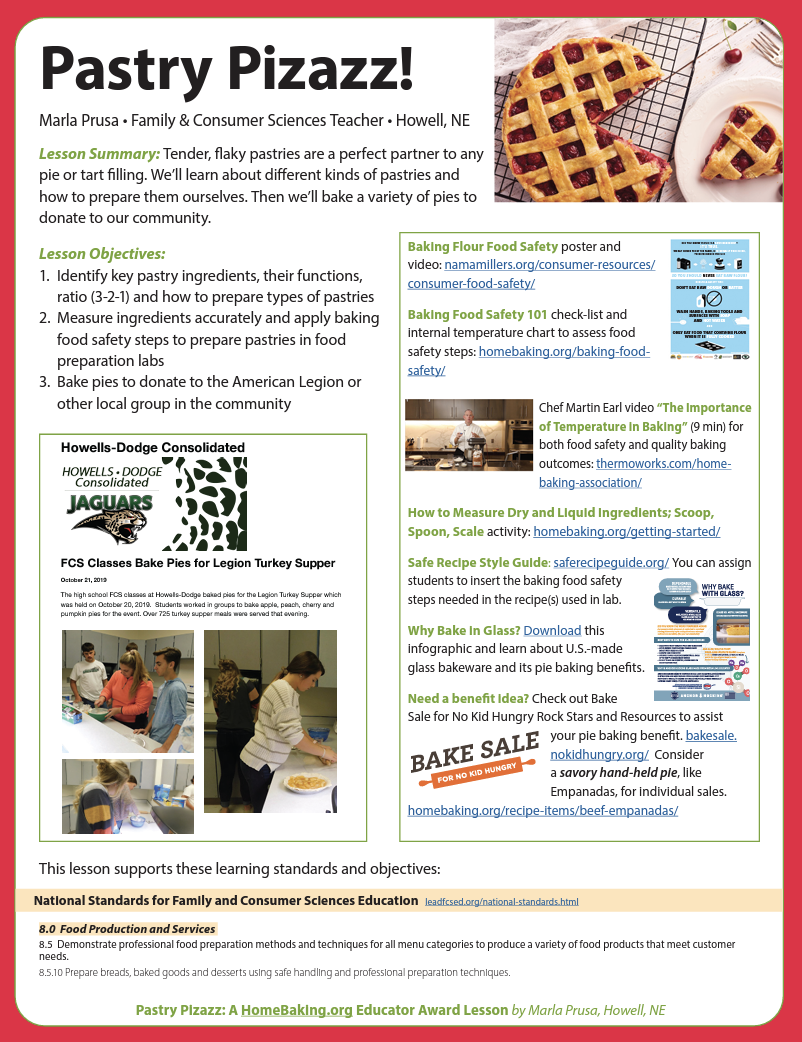
Lesson Plan: Tender, flaky pastries are a perfect partner to any pie or tart filling. We’ll learn about different kinds of pastries and how to prepare them ourselves. Then we’ll bake a variety of pies to donate to our community. Pastry Pizazz lesson plan here
Pie Plate Typically a 9” or 9.5” round slanted dish made of glass. Glass heats slowly, bakes evenly, browns bottom pie crusts beautifully to prevent a soggy bottom crust and allows you to see pie while baking. Perfect for baking pies, quiches, pot pies, and more. Learn more
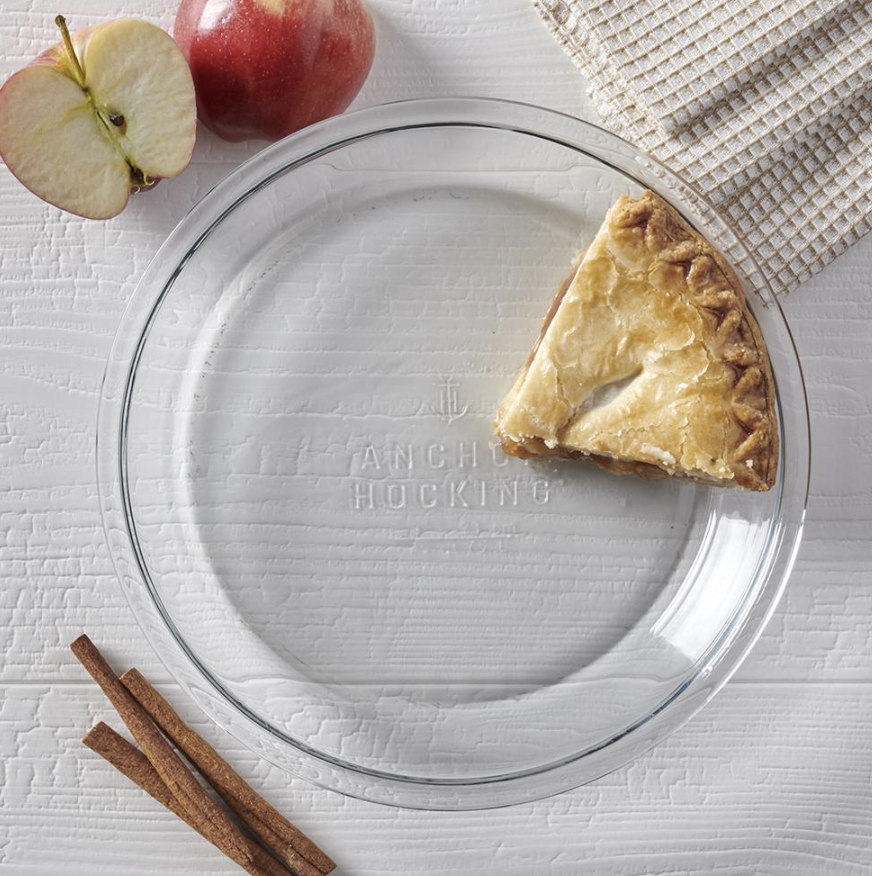
Plain Flour and Plain Cornmeal: Typically a southern mill product term that distinguishes soft wheat flour or cornmeal from self-rising flour or self-rising cornmeal. Plain flour and cornmeal don’t contain leavening and salt. See Homegrown Family Foods, and Sunflour products
Poolish Viennese bakers promoted this pre-ferment starter in the nineteenth century. Learn more.
Porous Honeycomb-like structure of white pan bread.
Portion (v.) To evenly divide batter or dough to place in prepared baking pans; (n.) the amount a person is served.
Pre-ferment Partial (yeast) dough made of flour, water, yeast and sometimes salt, given a quick mixing and allowed to ferment prior to mixing the full dough. Five traditional pre-ferments are: poolish (equal weights flour and water); scrap dough (old dough– pate fermentée); biga (flour+50-60% water+1/2% instant yeast); sponge (flour, yeast, water); mixed starter (flour+water+small piece old dough; mimics sourdough). Also See biga, sourdough and poolish.
Preheat Very important in baking. Heat the oven, griddle, skillet or broiler to the desired temperature before inserting the food. TIP: Always check the oven to be sure nothing is in it—and place the oven racks in the correct position before preheating. See Baking Temperatures Preheat Your Oven and a video.
Proof In bread-baking, the period of time a product is allowed to rise after shaping and placing in pans. Products are usually proofed until doubled in size, or when a finger, lightly placed on the side of the loaf, leaves an indentation. Products are “proofed” in a humid, draft-free, 95° F. to 100° F. place. (Avoid an environment that is too warm!) Plastic wrap sprayed with pan spray may be lightly placed over the product to prevent the dough from crusting (drying). Professionals use a “proof box” or cabinet with controlled temperature and humidity. (See Ripe Test)
Protein Comprised of amino acids, proteins are an essential nutrient group; in baking flour, “high protein” refers to the “strength” of the flour to produce gluten, comprised of two amino acids, glutenin and gliadin for bread and pasta products. Low protein flour will be used for soft, tender products (cakes, biscuits, cookies, pastries).
Pumpernickel Medium to coarsely ground, rye flour, light brown in color. It may be labeled “medium rye.” A mixture of rye and wheat flour used to produce a distinctive bread. Molasses are usually used to add color and flavor.
Punch To deflate a bread dough—when dough has doubled in size or when a dent remains after two fingers are lightly pressed 1⁄2 inch into the dough, make a fist and push it into the center of the dough. Pull the edges of the dough to the center and turn the dough over. Cover and let rest
or rise again before shaping. View Punching Down Dough
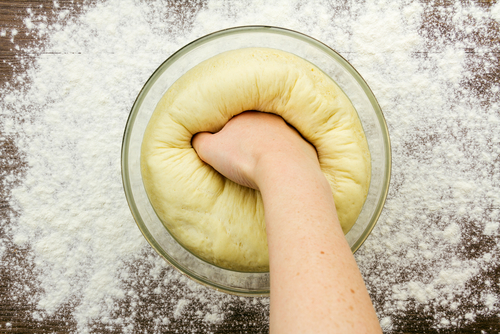
Puree To mash, process or sieve cooked fruit or vegetables to form a thick smooth liquid. Purees may be used to substitute for 1⁄4 of the oil or fat in some baked products.
Q
Quick bread Bread that is quick to make because it doesn’t require kneading, fermentation or rising time. Quick breads are usually chemically leavened (such as pancakes, waffles, biscuits, scones, cornbread, muffins, banana and zucchini breads), but using warm liquids and fast-rising yeast also results in a very short fermentation. EatWheat, Jiffy Quick Breads, Red Star Yeast, Home Baking Association Quick Breads, Shawnee Milling Quick Breads, Hammons Black Walnuts, Stone-buhr Flour, Heckers Cerestoa, National Festival of Breads, North Dakota Wheat, Sunflour Flour, Homegrown Family Foods, Texas Wheat
Quinoa flour Gluten-free flour made from grinding quinoa grain. It is highly nutritious and yields a tender, moist crumb in cookies, pancakes, waffles, and fruitcakes. See Ardent mills, King Arthur Baking, Whole Grains Council.
R
Rancid Having the bad smell or taste of spoiled (oxidized) fats or oils; nuts may also be rancid; rancid fats are a carcinogen and should not be consumed.
Ratio (a) The relation of one thing to another in size or amount. In baking use the weight of flour and each other part is in “ratio” to the flour.—Examples: (A) Crepe batter is 1 part flour to 1 part milk; Pie dough is 3 parts flour; 2 parts fat; 1 part water -3-2-1; Pound cake is 1 part flour to 1 part butter to 1 part eggs to 1 part sugar (same weight of each ingredient) (b) The quotient of one number divided by another–(Ex: “one out of 4 consumers prefers strawberry” so one divided by four is 1⁄4, or, 1 divided by 4 is 25%).
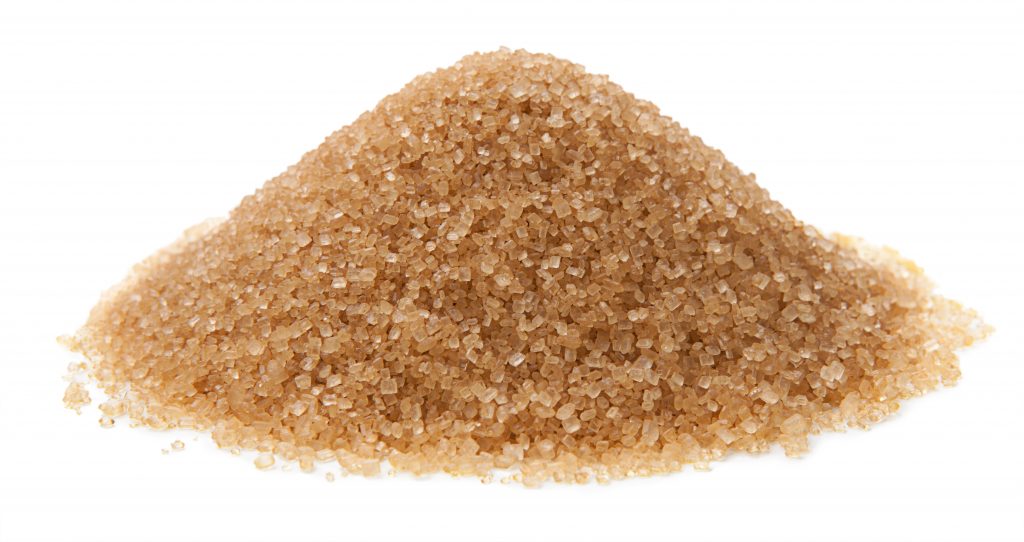
Raw Cane Sugar Also called turbinado and sometimes demerera sugar. About 98 percent sucrose; it is a tan coarse granulated solid obtained on evaporation of clarified sugar cane juice.It is processed just enough to make it safe to eat. Sugar Association
Red wheat In the U.S., wheat is classified into six classes — three of the classes have a bran coat that is considered “red” in color. These classes are hard red winter wheat, hard red spring wheat, and soft red winter wheat. Also, see White wheat. Learn more: Wheat Foods Council, Kansas Wheat, Oklahoma Wheat, Texas Wheat and Grain Craft Insights-Understanding Wheat..
Reconstitute To restore a former condition by adding water. Dried, minced vegetables, such as onions or leeks, should be reconstituted before adding to baked goods.
Reduced sodium A food has reduced the sodium content by at least 25% of that of the original food.
Red wheat In the U.S., wheat is classified into six classes — three of the classes have a bran coat that is considered “red” in color. These classes are hard red winter wheat, hard red spring wheat, and soft red winter wheat. Also, see White wheat. Learn more: Wheat Foods Council, Kansas Wheat. Texas Wheat
Resources Materials, time, money and abilities available for use that can be drawn upon for aid to create product or to take care of a need.
Rest time In baking, rest time refers to the bench rest or intermediate proof given the dough after kneading, punching and rounding the dough and before it is shaped. This gives the dough a brief (10 to 30 minutes) intermission in handling. The dough will be relaxes and more easily rolled or shaped. Keep dough covered with bowl or plastic food wrap sprayed with pan spray while it rests so “skin” doesn’t form. Learn more: Red Star Yeast
Ripe test (yeast dough) After the first “rise” or fermentation, the ripe test is used to see if dough is ready to be punched—or has “doubled.” The second ripe test is used to see if shaped loaf or rolls are ready to bake. Baking with Yeast: Step-by-Step Guide | Red Star® Yeast (redstaryeast.com)
Ripe test, First rise (Fermentation). See photos. Many factors, including the recipe, dough and room temperature, and humidity, will determine how long it takes for your dough to rise. Yeast dough is considered “ripe” when it has risen enough–usually doubling in size. The ripe test determines if the dough is ready to be punched down and shaped. Gently stick two fingers in the risen dough up to the second knuckle and then take them out.
If the indentations remain, the dough is “ripe” and ready for punch down. If not, cover and let the dough rise longer. Repeat test. Baking with Yeast: Step-by-Step Guide | Red Star® Yeast (redstaryeast.com)
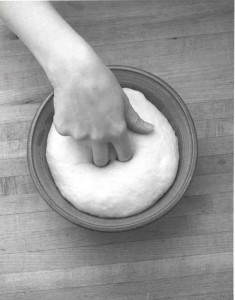
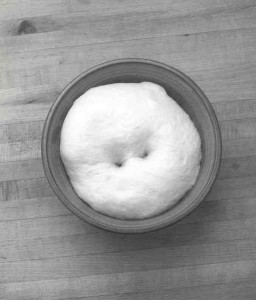
Ripe test – Second rise (or Proof) The ripe test to determine if a proofed loaf is ready for the oven is a little different than the method used after the first rise. Simply touch the side of the dough lightly with your fingertip. If the indentation remains, the loaf is ripe and ready for the oven. Source: Red Star Yeast
Rock salt Grayish, chunky, unrefined salt mined from halite; not recommended for table or cooking use; used most often for freezing ice cream.
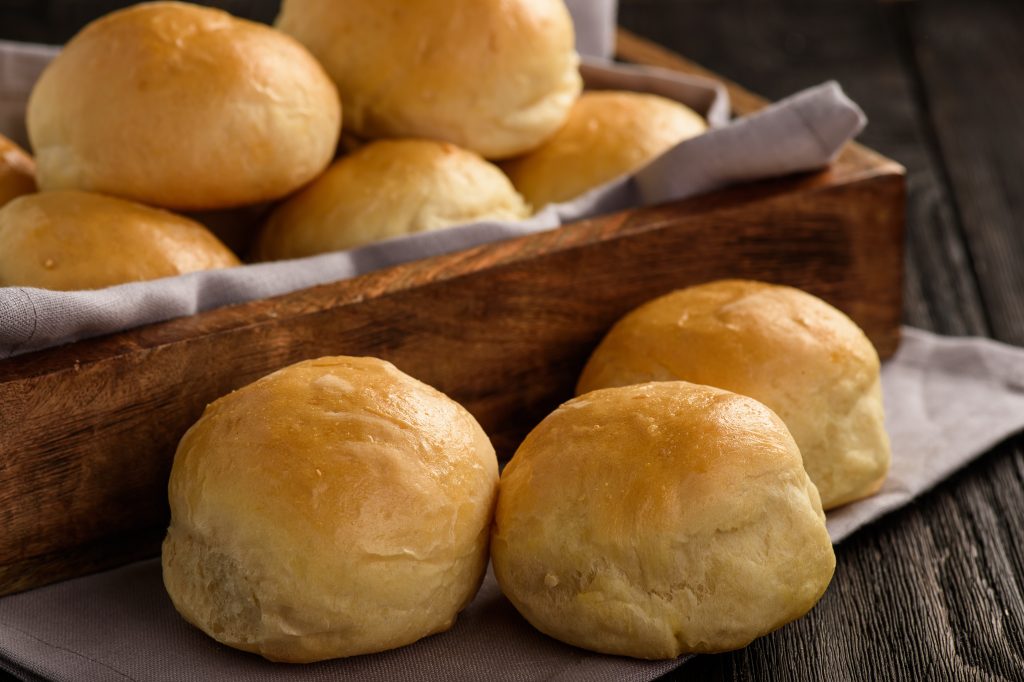
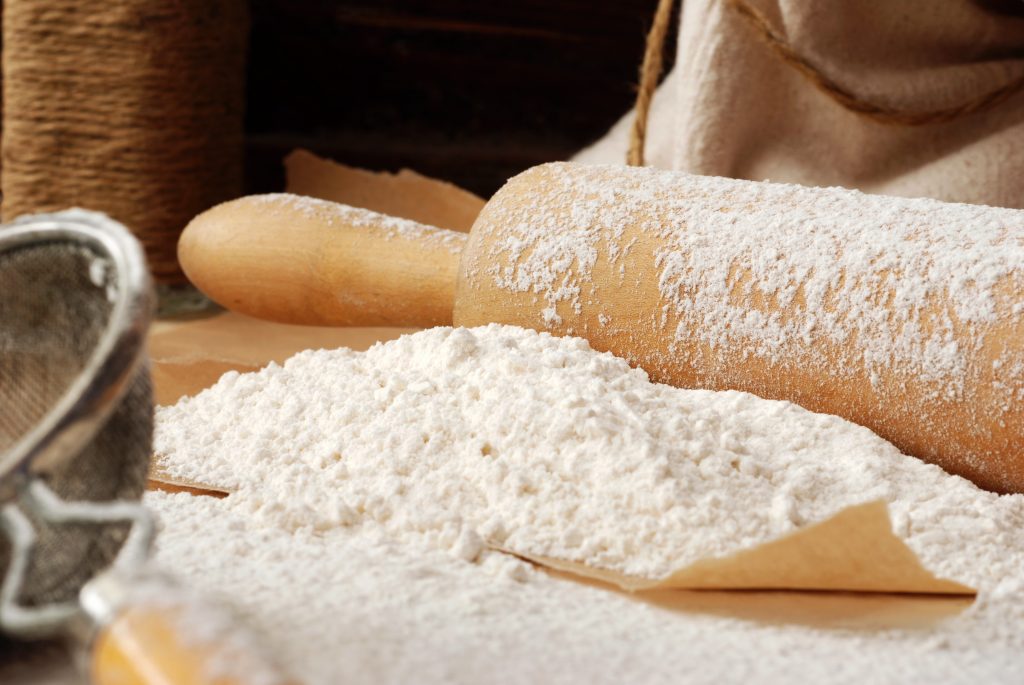
Roll (n.) A small dough piece (1.5 oz up to 4.5oz), that is smooth and rounded with dough skin smooth side up, rounded and pinched at the bottom See the process step-by-step with Baker Bettie. 2. (v.) To use a rolling pin to roll out a dough piece from center out forming a flat dough piece of even thickness for cookie cutting, pie crust or other products.
Rolled oats Whole grain oats or groats steamed and flattened with heavy rollers; quick-cooking rolled oats are cut into smaller pieces after rolling flat in thin flakes; other grains may be rolled too—barley, rye, wheat and more. Learn more: Types of Oats, Crops of the Northern U.S., Oat Nutrition
Room temperature In baking, ingredients at room temperature may be 62° to 70° F. (21°C.)
Rounding Shaping yeast dough so that a smooth surface encases the dough, sealing it at the bottom; rounding the dough is done before bench rest or intermediate proof. Round loaves are also shaped by rounding the dough piece. See Round Loaf Shaping in a Breadhead Minute.
Rye flour Milled from rye grain, the flour is darker, heavier, and low in gluten. It is sold as light, dark, or medium for home baking. The light and medium rye flour have most of the bran removed. Dark rye flour is whole grain. Sources: Ardent Mills, and Whole Grains Council, Rye and Rye Flour.
S
Safety (Baking Food Safety) Refers to the practices and guidelines that ensure baked goods are prepared, handled, and stored in ways that prevent contamination and protect consumers’ health. This includes proper sanitation of equipment and surfaces, accurate measuring and cooking temperatures, safe handling of raw ingredients (such as eggs and flour), and proper storage of finished baked products. Baking food safety is essential for preventing foodborne illnesses and promoting a safe kitchen environment for bakers of all ages.
Salt (Sodium Chloride – NaCl) Baking recipes/formulas will use, and specify table salt (non-iodized is often preferred) or Kosher salt. Salt can be produced three ways:
- Open-air evaporation of salt brine in shallow ponds (sea salt).
- Mining rock salt deposits.
- Boiling and evaporation of higher purity brine. Salt contributes to flavor in baked goods, and controls fermentation of yeast in breads. Coarse grades are available for use as toppings on soft pretzels and other specialty breads. Learn more here. See Graincraft Insight: Functions of Sugar and Salt in Baked Products. Also see Glossary entry for Kosher salt. Resource: A Baker’s Dozen Labs, Lab 10- The Savor of Salt Learn more: Sea Salt and Table Salt compared.
Salinity The level of saltiness in a food, water or product.
Sanitary Free from dirt or germs that could cause illness or disease; clean. Resources: Fight Bac, Home Baking Association, ACI
Satiety: completely satisfied or full
Saturated fats Fats that are solid enough at room temperature (70° F.) to hold their shape; usually animal fats, though palm or coconut oil are also included.
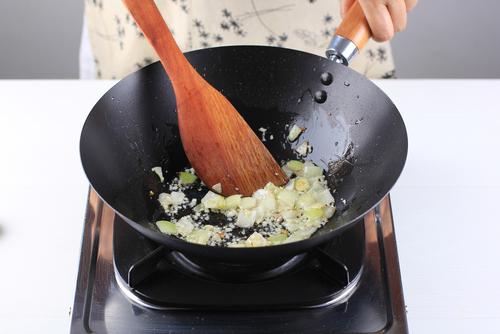
Sauté To cook in a small amount of fat, as you would fresh garlic, onion, leeks, etc., for enhanced flavor prior to adding to a savory dough.
Savor (n.) Full of flavor; (v.) enjoy the full flavor of food.
Scald To bring liquids (especially dairy milk) to a temperature just below boiling so that tiny bubbles form at the edge of the pan or cup to stop enzymatic activity that retards gluten development. Note: Yeast breads: Fluid dairy milk should still be scalded, the “skin” skimmed off and then cooled OR use a “high heat” dry milk for baking yeast breads. Source: High Heat Baker’s Dry Milk
Scale (n.) Kitchen device to accurately record the weight of an ingredient or food; bakers use for consistent results; scales may be balance, spring or electronic: (v) Bakers scale ingredients, batter and dough To weigh ingredients for a recipe or formula or batter and pieces of dough for equal portioning before shaping or distributing in pans. How to bake using a scale.
Scaling Dividing batter or dough by weight for the most accurate portioning into pans or pieces. Equal division of dough or batter between pans is very important for even baking and browning. Note: Scaling should be done quickly to avoid loss of leavening, or drying surface (so dough doesn’t form a “skin”) or over-aging of dough.
Scoop Dipper tool for portioning batter or dough. Common sizes:
- #12=1/3 cup or 2 1⁄2 to 3 oz (muffins)
- #24=2 2/3 tbsp. or 1 1⁄2 to 1 3⁄4 oz (cream puffs)
- #16=1/4 cup or 2 – 2 1⁄4 oz (muffins)
- #30=2 tbsp. or 1 to 1 1⁄2 oz (large drop cookies)
- #20=3 tbsp. or 1 3⁄4 to 2 oz (cupcakes)
- #40=1 1⁄2 tbsp. or 3⁄4 oz (drop cookies)
- #60=1 tbsp. or 1⁄2 oz (small drop cookies)
Scone A Scottish or Irish biscuit-like bread made with wheat flour, butter and leavened with baking powder-Scottish scones often include oats. Scones may be savory or sweet and are frequently served with breakfast or tea. Learn more: Irish Baker Chef Gemma Stafford, on Best-Ever Irish Scones and Baker Bettie, How to make Scones.
Score To make small shallow cuts on the surface of a food. View how to Score Bread here.
Scratch baking Baking method that begins with measuring basic ingredients such as flour, sugar, butter and leavening. It requires a recipe; today “speed-scratch” includes using a baking mix as one of the ingredients in the recipe.
Sealing Pinching the edges of dough that are brought together; securing or closing two sides of dough, packaging or product edges.
Sea salt Salt captured by the evaporation of sea water; the type used down through the ages.
Season To add herbs, spices, citrus zest, extracts or other ingredients to food for flavoring.
Seasoned salt Regular salt combined with a flavoring (Ex: onion, garlic, celery).
Seize Refers to melting chocolate that becomes a thick, lumpy mass due to even a small amount of steam or moisture getting into the melting chocolate. Chocolate may sometimes be unseized (although texture is still affected) by stirring in 1 tablespoon or less of vegetable oil, cocoa butter or clarified butter per 6 oz. of chocolate until smooth.
Self-rising cornmeal mix One of the first convenience baking mixes. It is a blend of white or yellow cornmeal, enriched flour, baking powder, and salt. NOTE: Self-rising cornmeal differs from the mix—it does not contain flour. Approximate equivalent for self-rising cornmeal mix = 1 1⁄2 cups cornmeal, 1⁄2 cup all-purpose flour, 1 Tablespoon baking powder, and 1 teaspoon salt. Hecker’s Self-rising products, Homegrown Family Foods, Shawnee Milling, Sunflour
Self-rising flour One of the first “convenience mixes,” self- rising flour is a blend of all-purpose flour, baking powder, and salt. When self-rising flour is used in a standard flour recipe, the baking powder and salt are then omitted. Approximate equivalent = 1 cup all-purpose flour, 1 1⁄2 teaspoons baking powder, and 1⁄4 to 1⁄2 teaspoon salt. Hecker’s Self-rising Flour, Homegrown Family Foods, Shawnee Milling, Sunflour
Semi-sweet chocolate Baking dark chocolate that contains a minimum 15 percent and up to 35 percent chocolate liquor, plus cocoa butter, a variable amount of sugar, lecithin (an emulsifier), and vanilla. It may be used interchangeably in some recipes that call for bittersweet or sweet chocolate, but is not interchangeable with milk chocolate.
Semolina flour Flour produced by further grinding semolina (granules) made from durum wheat. Specialty breads sometimes call for part semolina or semolina flour. Also called pasta flour.
Separate To remove the yolk from the white of the egg.
Serving A specific amount of food adequate for nutrition management and health.
Shaping or molding See Resource, Dough Sculpting 101, (30 segments on shaping dough and sculptures) www.homebaking.org/store/
Sheet cake Flat cake baked in a sheet pan, frosted and cut- into squares or triangles.
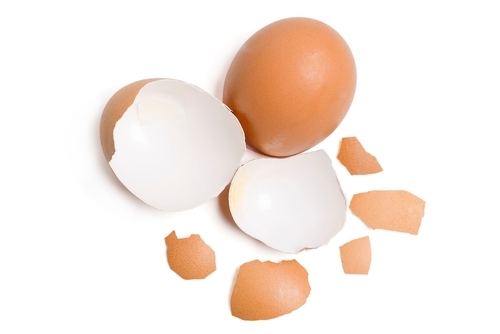
Shell (n.) The outer protection of an egg (v.) remove the egg from the shell (“shell the egg”).
Shortening A blend of vegetable oils (soybean, palm or cottonseed) that is a neutral flavor, fat with no water content that is solid and shelf-stable at room temperature (so doesn’t require refrigeration.) It has a high smoke point. Baking shortening is usually “hydrogenated”– hydrogen is added to the heated oils and converts the liquid oil to a semi-solid. For home bakers, all-purpose shortening is sold in a can or in stick form. There are also cake or icing shortenings sold that contain emulsifiers that help cake retain moisture.
Substitutions: Lard and coconut oil also “shorten” and contain no water. They will perform differently than hydrogenated shortening and flavor will vary too. For each cup shortening reduce lard amount by 2 Tablespoons. Butter is not a 1:1 substitution since it is 20% water/dairy whey. Learn more: The Spruce Eats
Short Patent Flour: This wheat flour milling process puts the wheat through more grinding and sifting with finer-meshed sieves than in standard milling. Also, the short patent process sifts away more by-product, leaving only the heart of the wheat kernel (endosperm). The result is a flour that is smoother in texture and produces baked goods that are consistently light and fluffy.
Shred To rub large food pieces across medium to large grater holes or slits to make small pieces.
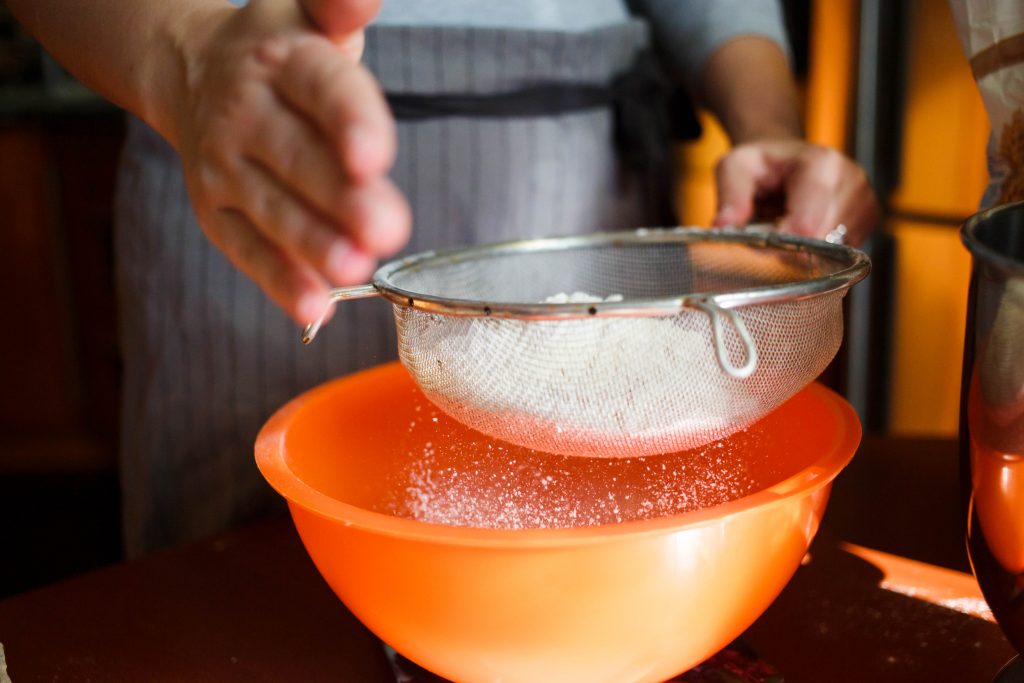
Sift To move flour or sugar through a sieve (sifter) to incorporate air and insure accurate measurement.
Sifting notes: Today most flour is pre-sifted and needs only to be stirred until light, scooped into the measuring cup until heaping and leveled. Sift only if recipe directs you to do so prior to measuring—this alters the volume of the flour or powdered sugar measured. Blend dry ingredients (flour, leavening, salt) with a wire whisk, not a sifter, for best results.
Simmer To cook in liquid that is barely at the boiling point and small bubbles rise below the surface.
Skim To remove a substance from the surface of a liquid. Ex: “Skim” the milk after scalding.
Slack dough Dough that is too fluid due to under- development or too much water/too little flour.
Slash also Slashing To cut shallow incisions in the surface of bread or rolls for proper expansion while baking. Done just before baking.
Snail A round loaf made by shaping a long smooth strip of rich sweet bread dough in a snail shape and proofing in a round layer cake pan. Resource: Dough Sculpting 101 DVD. Free Lesson w recipe and guide. Portuguese Sweet Bread or Pao Doce pictured.
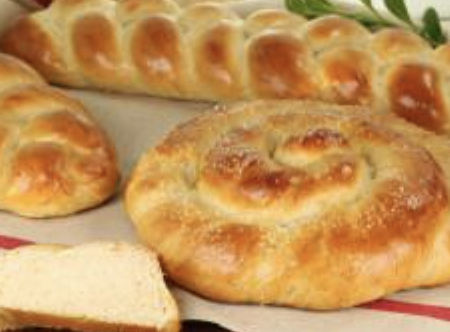
Sodium guidelines 2400 mg or less per day. The American Heart Association recommends no more than 2,300 milligrams (mgs) a day and an ideal limit of no more than 1,500 mg per day for most adults. Learn more, Downloads, Infographics:
Smart Snack Baking recipes that are whole grain rich and control saturated fat, sugars, sodium to be in compliance with the Nutrition Standards for All Foods Sold in Schools (Smart Snacks in School Standards, 2010.) Find smart snacks culinary baking recipes here.
Soda-Lime/Soda-Lime-Silicate Glass Type of glass used to make Anchor Hocking bakeware. Glass bakeware made of soda lime is stronger and more durable, fully suitable and safe for oven use. It is also an environmentally friendly 100% recyclable glass product. Learn more
Soft wheat Refers to soft red winter wheat, soft red spring wheat, and soft white wheat. “Soft” wheats are especially suited for pastries, cookies, cakes, flat breads, quick breads and more. See Grain Craft Insights, Understanding Wheat and Flour, Homegrown Family Foods, Jiffy Baking Mix, Stone-buhr All-purpose Flour, Sunflour, Washington Wheat
Sorghum flour Milled from sorghum grain, a food crop native to Africa; gluten-free; in baking, requires a binder (such as xanthan gum or cornstarch) to add “structure” and is usually a whole grain; popular in multi-grain breads. White sorghum, pictured, is a food use sorghum and red sorghum is typically used for feed. Sources: Ardent Mills, Whole Grains Council and Nebraska Cooperative Extension, How to Bake Gluten-Free with Sorghum.
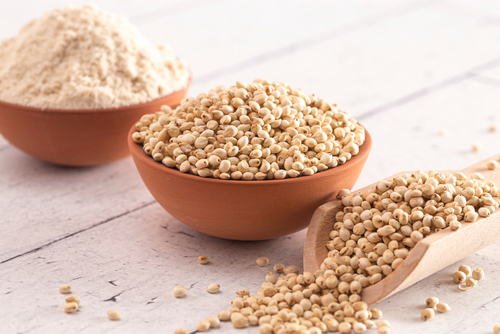
Image courtesy of Ardent Mills.
Sour dough Bread with a slightly sour tangy flavor created by using sour dough starter (levain)—a batter or dough that has colonies of sour dough yeasts and bacteria (microflora). Learn More King Arthur Baking on Sourdough, Red Star Yeast
- Step 1: (Sponge/Pre-ferment): Mix 60 to 100% of flour and all of liquid and yeast for 4-6 minutes; let ferment at 75° F. for 3-6 hours. (Sponge temperature=72-78 ̊ F.—after fermentation, rises 10 ̊ F.)
- Step 2: Add remaining ingredients and mix to develop gluten (8 to 12 minutes). Ferment again 0 to 40 minutes at 80-85 ̊ F. Punch down the dough and proceed to shape/make up.
Sponge and dough Two-stage yeast bread mixing process. Step 1: (Sponge/Pre-ferment): Mix 60 to 100% of flour and all of liquid and yeast for 4-6 minutes; let ferment at 75° F. for 3-6 hours. (Sponge temperature=72-78 ̊ F.—after fermentation, rises 10 ̊ F.) Step 2: Add remaining ingredients and mix to develop gluten (8 to 12 minutes). Ferment again 0 to 40 minutes at 80-85 ̊ F. Punch down the dough and proceed to shape/make up.
Spread The amount a dough or batter flattens out on a baking pan before the oven heat sets the proteins and starch;
Spreads Products in sticks or tubs that are less than 80 percent fat. These reduced or lower fat products (60 percent or less fat) should be used in baking recipes specifically developed for the product.
Sprouted flour Made from a whole grain (such as whole wheat) that has been soaked and left to germinate (or sprout), then dried and milled into flour. Baking with sprouted flour produces a sweeter, lighter tasting product. Learn how: Chef Stephanie Petersen, R&D Chef, TIP: Substituting sprouted flour for non-sprouted flour in a recipe – increase the amount of liquid by one tablespoon per cup of sprouted flour. Learn more
TIP: Substituting sprouted flour for non-sprouted flour in a recipe – increase the amount of liquid by one tablespoon per cup of sprouted flour. Learn more
Sprinkle Scattering particles of sugar or toppings over a surface, like frosting, cake or bread.
Stabilize To make resistant to change in condition or position; set.
Stale No longer fresh; poor quality made by being kept too long or stored in the wrong environment. Learn more Yeast Bread Handling and Storage
Standard or standardized In home baking, this refers to well-tested recipes, measuring tools, ingredients, methods, and equipment that are used to produce a defined product with consistent results to assist manufacturers or consumers.
Staple The chief item, resource or most important items made, grown or sold in a particular place, region, country, or culture to support life there.
Starch 70 to 75% of flour is starch. During milling a small portion are damaged. Quality wheat and short extraction flour contain fine quality starch granules and protein important in mixing, dough conditioning water absorption, fermentation and quality crumb formation.
Starch damage 70 to 75% of flour is starch. During milling a small portion of the starch may be damaged. Quality wheat and short extraction flour contain fine quality starch granules and protein important in mixing, dough conditioning water absorption, fermentation and quality crumb formation. Learn more about Flour, starch and the testing used to tell if there is starch damage. Resource: Grain Craft Insights. Understanding Flour
Starter A mixture of flour, water, yeast and sugar that is allowed to ferment in a warm place until foamy. A portion of the starter is used (about 2 cups) in place of a package of yeast in breads, usually after “feeding” the mixture with additional flour and water. Starters are kept in the refrigerator after initial development and “fed” every two weeks. Resource: How to Make a Sourdough Starter Guide with Chef Gemma Stafford.
Steam To cook in steam, with or without pressure, as with steam bread or Chinese dumplings.
Stevia Also known as sweetleaf; a naturally occurring sweetener native to Central and South America; 400 times sweeter than sugar. Stevia and sugar blends are approved in baking, allowing for reduced sugar in the recipe when recipe functions with less sugar. Learn more: Food Insight, International Food Information Council, ific.org
Stir To mix with a spoon or whisk in a circular motion to blend or evenly cook ingredients.
Stoneground flour or meal A stone mill, also known as a grist mill, grinds a variety of grains using buhr stones instead of steel rollers; the flour or meal texture varies from coarse to fine. The flour or meal is not nutritionally superior to roller milling but is usually sold freshly milled or as close to fresh as possible. Two examples: Marion Milling, Kansas City, MO and The Grain Shed, Spokane, WA.
Straight dough All (yeast dough) ingredients are mixed together in the order the formula or recipe directs until a smooth, stretchy dough is formed. Dough should be about 80- 82° F. when mixed. It is then fermented for 1 to 2 hours at 80- 85° F., punched and so on.
No-time straight dough A commercial method, includes oxidizing and reducing agents added so very little fermentation is needed. In home baking, fast rising or instant yeasts will simulate this method by using higher water temperatures (up to 130° F.) to make “no- time” yeast dough (10 minute rising time). See Platinum Yeast.
Strain To separate solid from liquid (as in clarifying butter).
Structure Composition and framework of a product.
Sucrose A crystalline, water soluble sugar naturally occurring in sugar cane, sugar beets, and sorghum; widely used in baking, sucrose is sweeter than glucose and not as sweet as fructose.
Sugar Sugar or sucrose is a carbohydrate occurring naturallyin every fruit and vegetable in the plant kingdom. It is the major product of photosynthesis, the process by which plants transform the sun’s energy into food.

Download Sugar STEM Field to Table, Grades 7-12, English and Spanish. Also Resource Toolkits GR K-2; Gr 3-6 and Gr 7-12.
Sugar for home baking is produced in greatest quantities from sugar cane and sugar beets.
- Brown sugar: Sugar crystals contained in a molasses syrup with natural flavor and color components. Dark and light brown sugars may be substituted according to individual preferences for product color or taste. See Types of Sugar.
- Demerara sugar: Demerara cane sugar is crystallized from the initial pressing of pure cane and has a light golden color from the molasses left behind after minimal processing, a slightly larger crystal than granulated sugar and a delicate crunchy texture. It is perfect for baking, sweetening your coffee or as a topping on your cereal, fruit or desserts. Also may be called turbinado and raw cane sugar. See Types of Sugar. It is processed just enough to be safe to eat.
- Granulated sugar: Fine or extra-fine white sugar crystals. Often referred to as “white sugar” in home baking. See Types – White Sugar, Brown Sugar, Liquid Sugar | Sugar.org
- Muscovado sugar: Another type of unrefined sugar, darkly flavored from sugarcane juice left in during the production process. It tends to be sticky and can be used just like brown sugar. See Types – White Sugar, Brown Sugar, Liquid Sugar | Sugar.org
- Raw Cane Sugar: About 98% sucrose and tan or brown in appearance; it is a coarse, granulated solid obtained on evaporation of clarified sugar cane juice. See
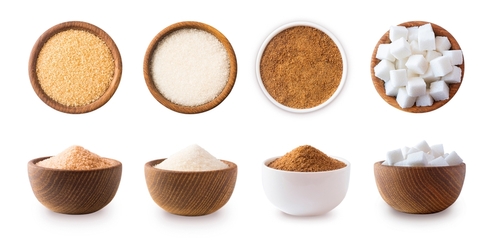
T
Turbinado sugar: Partially processed sugar with retains more naturally present molasses. Sometimes also called Demerera Sugar or what’s in your packet labelled Raw Cane Sugar. It is processed just enough to be safe to eat. Types – White Sugar, Brown Sugar, Liquid Sugar | Sugar.org
Teff flour Produced from the teff grain, native to the Horn of Africa and commonly used to bake injera, an Ethiopian pancake-like flat bread. Like other gluten-free flours, teff flour often requires a binder (such as xanthan gum or cornstarch) to add “structure.” A healthy whole grain, teff also provides more calcium than other grains. Teff flour has a mild, chocolate flavor to it, making it a great flour substitute in sweet baked goods. Learn more: Ardent Mills, Whole Grains Council
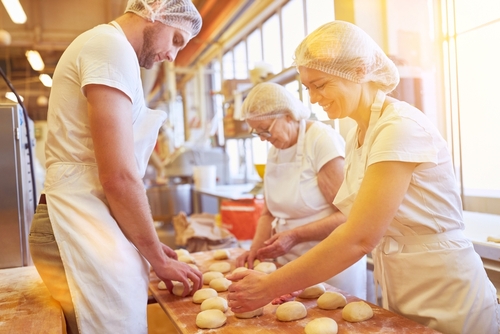
Teamwork The coordinated effort of people working together.
Table salt A fine-grained refined salt with additives that keep it free-flowing; common baking and cooking salt. It contains the same amount of sodium as sea salt. Non-iodized table salt is often preferred by bakers. Also see Kosher Salt for guide in substitution.
Temperature The intensity of heat in a mixture, baked product, or oven; measured in degrees Fahrenheit (°F) in home baking in the United States. View Quality Baking Temperatures with Chef Martin Earl and download Baking Temperatures by Thermoworks.
Tempered Glass Bakeware – Process in which glassware is subjected to sustained heating followed by rapid cooling to enhance strength and increase durability. Learn more
Texture Indicates the appearance of a cut portion of bread or cake.
Thicken Make a liquid dense by adding an ingredient like cornstarch, egg yolk, tapioca, flour, rice or potato starch or flour; also to bind.
Toss To mix ingredients lightly by lifting and dropping with a spoon, or spoon and fork.
Twist Turn two strands or sections in opposite directions
Turbinado Sugar Raw sugar that has been refined to a light tan color by washing it in a centrifuge to remove surface molasses. Also may be called Turbinado or Raw Cane Sugar Learn more
U
Ultragrain Flour 100% whole wheat flour made by using a special flour milling process developed to produce a lighter- colored, ultra smooth texture whole grain wheat flour with the texture of white flour. Learn: Ultragrain
Underproofed dough Young dough; dough not allowed to raise enough before baking.
Underproofed loaves or rolls Shaped bread or rolls which have not reached the desired height or volume before they are baked.
Unleavened A word to describe breads, cakes, or other baked goods that do not use a leavening agent, such as baking powder, baking soda, yeast, or cream of tartar.
Unbleached flour Flour that is bleached naturally as it ages; no maturing agents are used in the milling process. It may be used interchangeably with bleached flours and has no nutritive differences. See Wheat Flour 101
Unsaturated fats Refers to vegetable oils that are fluid at room temperature or the fats in plant-based foods such as corn, sunflower, soybeans, canola, nuts, seeds, avocados, olives.
Unsweetened chocolate Dark baking chocolate containing no sugar or milk solids; made from cocoa liquor and cocoa butter.
V
Value-added Ingredients, artisan shaping or design that when included in or added to a product will increase the nutritional, market or consumer value of a baked good. Resources: Bake for Funds; Bake to Give.
Vanilla beans Gourmet vanilla beans are used in home baking and gourmet culinary creations. This is the purest form of vanilla. To use the vanilla beans, you will need to learn how to split and scrape the vanilla beans. Click here for a reference.
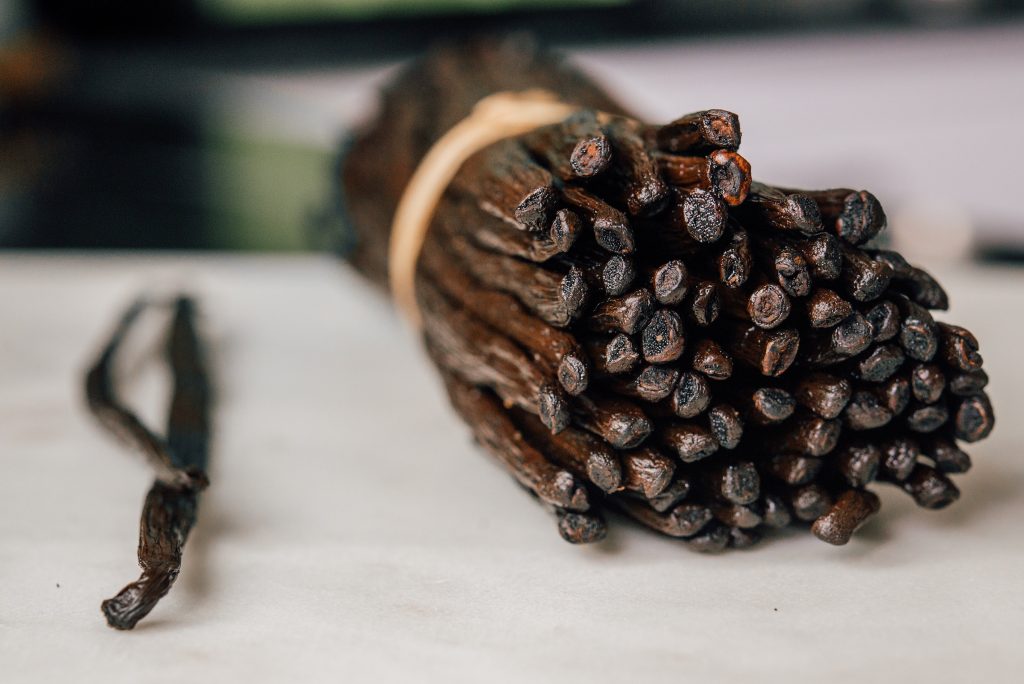
Learn how vanilla is produced responsibly by vanilla farmers in their vanilla production used.
Vanilla extract Vanilla extract is defined by the US Food and Drug Administration to contain a minimum of 35% alcohol and 13.35 ounces of vanilla beans per gallon of extract produced. Because of this, the only ingredients in pure vanilla extract should ever be: water, alcohol, and vanilla bean extractives. Some manufacturers may add the following optional ingredients: Glycerin, Propylene glycol, Sugar (including invert sugar), Dextrose, or Corn syrup (including dried corn syrup). For more frequently asked questions on vanilla, click here plus more about vanilla.
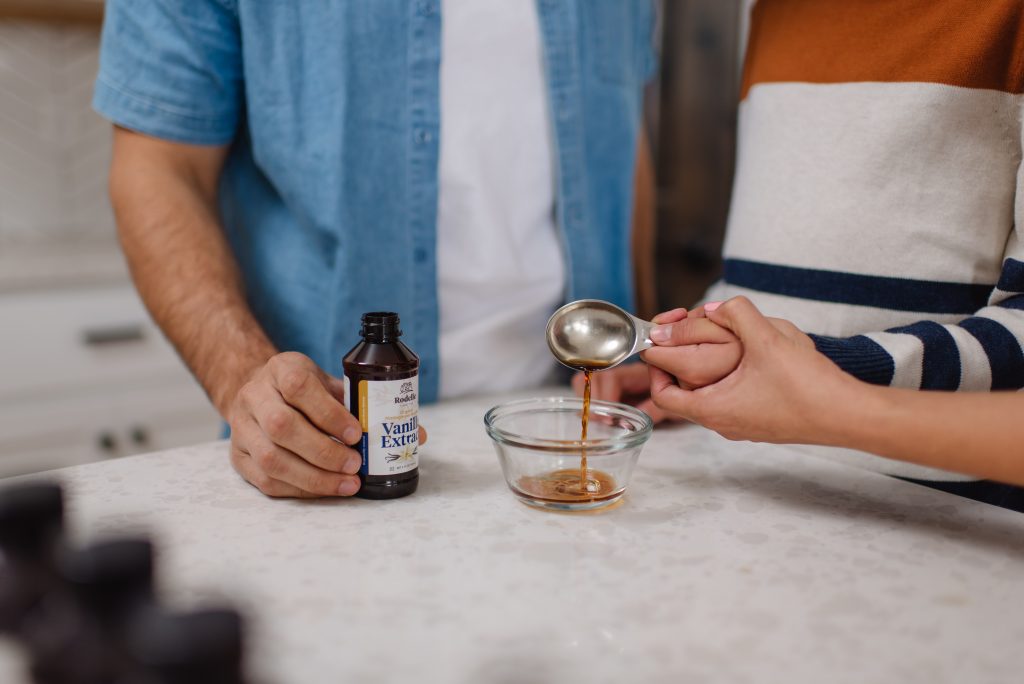
Vanilla paste Vanilla paste is a mixture of pure vanilla extract, vanilla beans, and a sweetener. Most vanilla pastes are quite pourable and offer a deep, rich taste of vanilla. Bakers who want to see flecks of vanilla bean in custards, frostings or whipped cream sometimes favor vanilla paste because it is easier to use than splitting and scraping out vanilla bean seeds. Use as a substitution in your favorite recipes: we recommend a 1:1 ratio for vanilla beans and vanilla extract. EX: 1 tsp vanilla extract = 1 tsp vanilla paste. Learn more
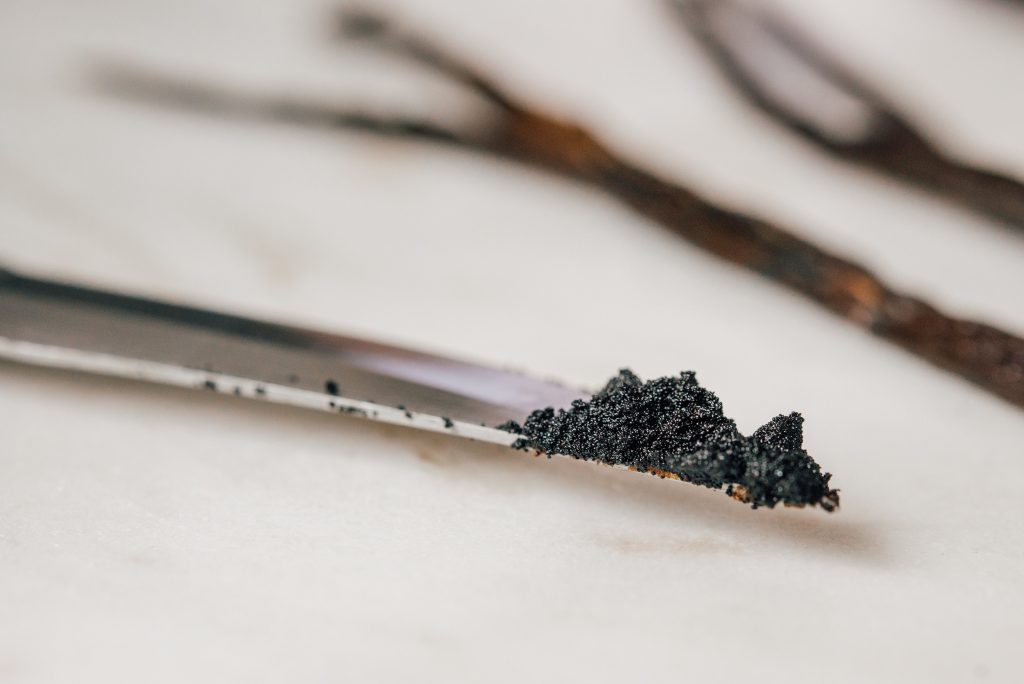
Vegetable oil See Oil.
Vegetable shortening Made from a blend of vegetable oils that have been hydrogenated. Adding hydrogen to the heated oils converts the liquid oil to a semi-solid. Shortening is shelf-stable at room temperature. It has a high melting point making it easy to use at a variety of temperatures. See Shortening.
Vent To leave an opening through which steam can escape in the covering of a food. EX: Vents are cut in the top pie crust.
W
Walnuts – The seed of a deciduous tree, consisting of edible kernels contained within a hard shell which is encased in a green husk. The two main varieties of walnuts used in baking are English Walnuts and the native American Black Walnuts. Learn more
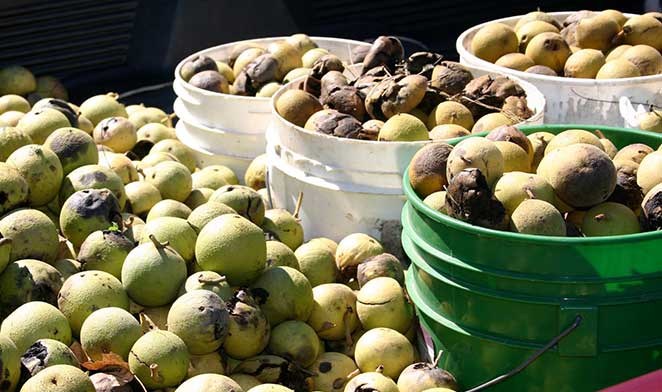
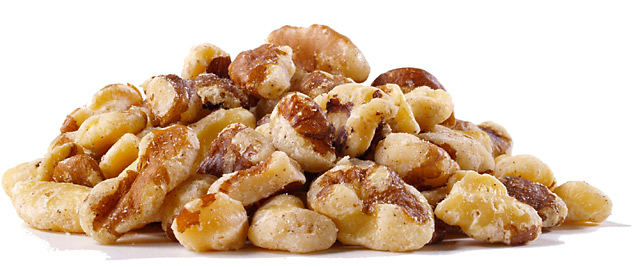
Water Very hard water and soft water create problems for baked goods. Tap water of medium hardness and without noticeable chlorination or other off odors is suitable. Bottled water may be used in very hard water regions. (Soft water=15-50 ppm; Medium hard=50-100 ppm; Hard=100-200 ppm; Very hard=over 200 ppm).
Water content The amount or percentage water is of the total weight of an ingredient or product.
(Ex: a 4 oz sweet potato is 80% water or 3.2 oz water).
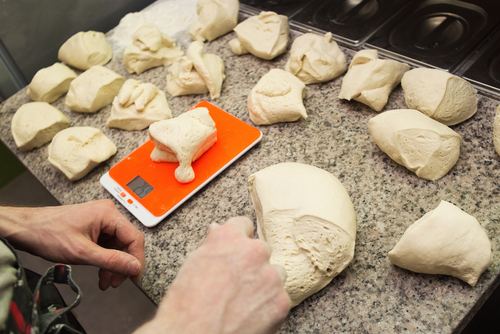
Weigh To use a scale to determine the weight of ingredients, dough pieces, the baked product or net weight.
Wheat-allergic People who have an IgE-mediated response to wheat protein (not necessarily the gluten portion). These individuals must only avoid wheat, not other grains. Most children who are allergic outgrow the allergy. Learn more Food Allergy Network, Resource: Kitchen Science: Baking for Special Needs.
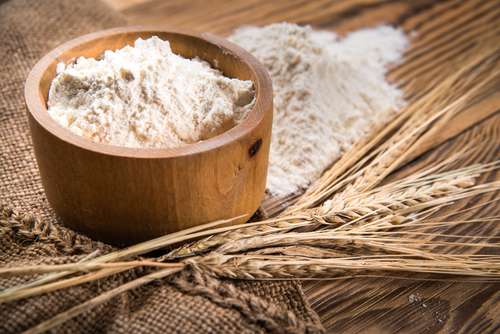
Wheat Flour Flour milled from soft, red or white wheat for cakes, pastries, waffles, and other products, or hard white or red wheat for pizza crust, yeast breads, bagels, and some rolls or hearth breads. High-protein durum wheat will be used for flour or semolina for some specialty breads, but is primarily a pasta wheat. Home baking (called “family flour” in the milling industry) wheat flour may be: Unbleached or bleached all-purpose, cake, pastry, whole wheat, stone-ground or graham, ultra-grain and bread flour. All flour is a raw commodity and should be cooked or baked before consuming.
Access Baking Flour and Food Safety resources.
View Did You Know? Flour Food Safety video.
Learn more: Wheat Flour 101; View The Journey of Wheat from Field to Flour and How Flour is Milled; Visit Wheat and Flour Milling members at Home Baking Association
Whip Beating a food lightly and rapidly with a mixer, whisk or beater to incorporate air and increase volume.
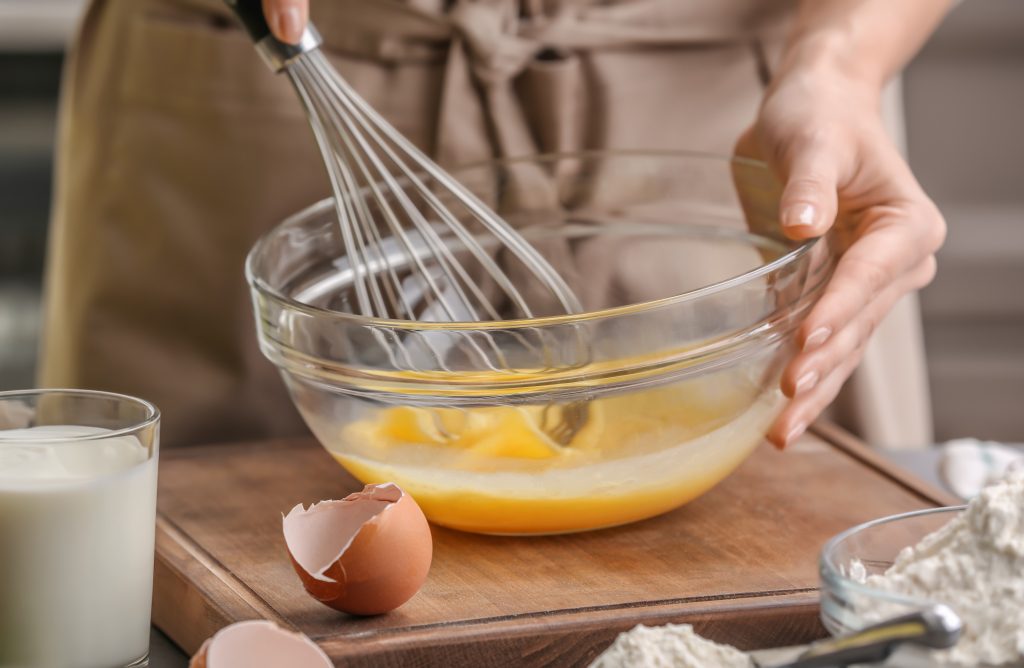
Whisk To beat ingredients together, using a wire whip or whisk, until well blended.
White chocolate A mixture of sugar, cocoa butter, milk solids, lecithin, and vanilla. If cocoa butter is not mentioned, the product is confectionery or summer coating, not white chocolate. It is not a true chocolate due to no chocolate liquor present. Chips or pieces and coating chunks are popular home baking ingredients.
White wheat In the U.S., wheat is classified into six classes — three classes have a bran coat that is considered “white” or pale to amber in color. These classes are soft white wheat, hard white wheat, and durum wheat. Learn more: Colorado Wheat, Wheat Foods Council,Jiffy Mix,UltraGrain, Washington Wheat, Wheat 101, Which Wheat for What?
Whole grain or foods made from them contain all the essential parts and naturally-occurring nutrients of the entire grain seed in their original proportions. If the grain has been processed (e.g., cracked, crushed, rolled, extruded, and/or cooked), the food product should deliver the same rich balance of nutrients that are found in the original grain seed, meaning that 100% of the original kernel – all of the bran, germ, and endosperm. Learn more:
Whole Grain Stamp A packaging logo that helps shoppers identify whole grain products. The number on the Stamp indicates how many grams of whole grains are in a serving of the product. There are three Stamps. Source: Whole Grains Council
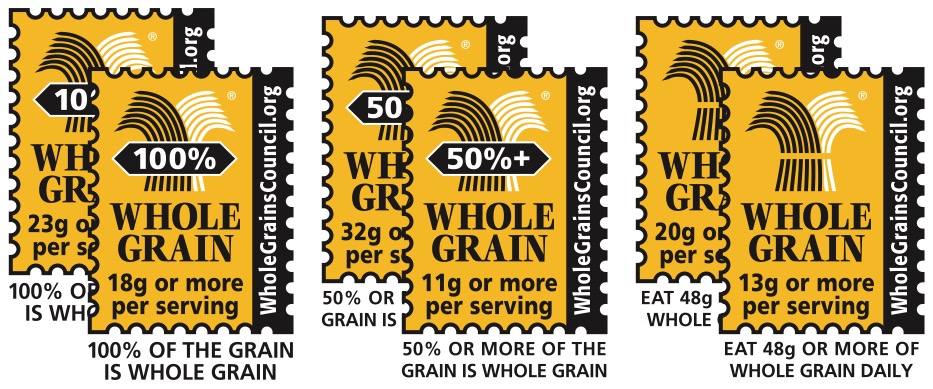
Whole wheat flour Flour produced from the whole kernel (bran, germ and endosperm) of wheat. Also called graham flour; in Canada, look for “whole grain whole wheat” on the food label. It is usually produced in flour mills but may be ground in a stone or home mill. Learn more
Whole white wheat flour See whole white wheat entry above. The classes of U.S. wheat grown are red, white or durum (pasta) wheat. Any wheat can be used to produce a whole wheat flour. Whole white wheat flour is nutritionally equivalent to a flour produced from soft (lower protein) or hard (higher protein) varieties of white wheat. Learn more: Ardent Mills, King Arthur Baking, Stone-Buhr, Washington Wheat Foundation, Wheat Foods Council
X
XXX or XXXX confectioners sugar Indicates the fineness of the powdered sugar. Four X is slightly finer, but both may be used interchangeably. It does not affect whether sifting is required — go by the recipe’s directions. Learn more: C&H Sugar, Domino Sugar
Xanthan gum A gluten substitute in baking; a polysaccharide gum derived by fermenting corn dextrose, and used in gluten- free baking to thicken, emulsify, and gel or stabilize the batter or dough without the benefit of gluten.
Y
Yeast Baker’s yeast (differs from Brewer’s yeast) refers to a single-celled fungi in the species Saccharomyces cerevisiae. Yeast is a living organism that ferments (eats) sugar and acts as a leavening agent in yeast doughs. The by-products of yeast fermentation are carbon dioxide (CO2) and alcohol. The carbon dioxide produced during fermentation is trapped in the dough and allows the dough to rise or expand. During fermentation other flavor compounds are formed along with the alcohol that later react in the oven to give yeast-raised baked goods their characteristic flavor and aroma.
- Baking yeast Available to home bakers in two forms: dry yeast (Active Dry Yeast or Fast-Rising Instant Yeast) and wet yeast (also known as fresh or cake yeast).
- Active dry yeast (ADY) A moderate-acting dry yeast; traditionally required rehydration prior to use; today may be rehydrated in a small amount of warm liquid (110° -115° F) with sugar OR blended directly with the flour/dry ingredients prior to adding warm liquids.
- Fast-rising or instant yeast (also sold as Bread Machine yeast) A fast-acting dry yeast; typically blended directly with all dry ingredients prior to addition of warm liquids (120° – 130°F).
- Active dry yeast and fast-rising/instant yeast May be used interchangeably in home recipes. With faster-acting instant yeast, the dough may rise faster; with moderate- acting active dry yeast, the same dough may rise more slowly. Simply monitor how the dough is rising and adjust time accordingly. For use in bread machines, adjust amounts according to manufacturer’s recommendations.
- Red Star® Platinum Superior Baking YeastTM
A 2-in-1 instant yeast blended with dough strengtheners. A stronger dough is more tolerant to variations in the dough-making process and will “trap” more of the leavening produced by the yeast to yield a better oven spring and a superior volume in the finished baked good. Platinum Yeast may be used in any recipe. For more info - Fresh or cake yeast May also be available seasonally in limited markets in the U.S. When a store stocks cake yeast, it is found in the dairy section. Fresh cake yeast is currently sold in 0.6 oz. and 2 oz. sized blocks. You’ve Got Flour What About Yeast?
- Usage guide: One dry yeast package = 1⁄4 ounce/7 grams and is about 2 ¼ teaspoons and equals one “small” 0.6-ounce cake of compressed fresh yeast or one third of a 2 oz. fresh yeast cake. One 1⁄4 oz./7g package (2 1⁄4 teaspoons) of dry yeast OR 0.6 ounces of fresh cake yeast (one-third of a 2 oz. yeast cake) will raise up to 1# (or approximately 4 cups) of flour. For more info and a conversion table, visit
- Baker’s tips: Use a thermometer to measure liquid temperature before adding it to or with the yeast. If it is too hot for you to touch, it is too hot for the yeast. Yeast ferments slowly under refrigeration 33 to 40° F, more actively at room temperatures. Yeast does not die if frozen, but will die in temperatures above 140° F.
- Baking Temperatures provides both process and internal temperatures for yeast bread baking.
Learn: All about Yeast from Red Star Yeast
More Resources: Red Star Yeast Resource Guide
and Science of Yeast resources. Home Baking Association Yeast Resources: Baking Temperatures, Temperatures for Yeast Bread Production, and What Happened to my Yeast Bread
Yeast temperatures Refer to Baking Temperatures. Guide
Yield The amount of product obtained as a result of a given amount of ingredients.
Z
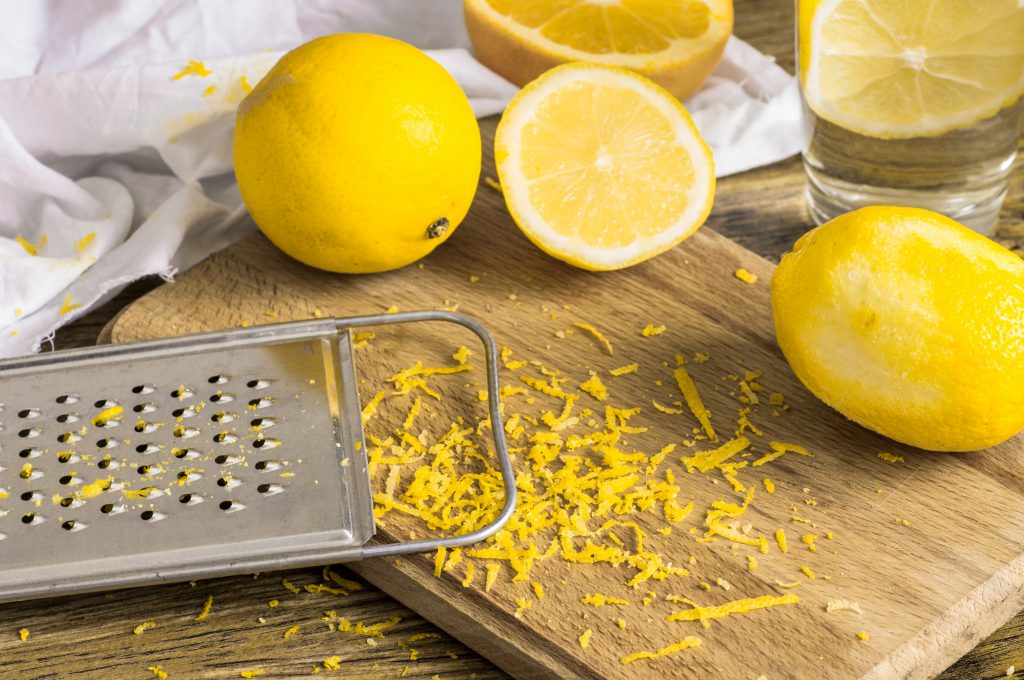
Zest The fragrant, flavorful, thin, outer skin of citrus fruit which is removed with a citrus zester, vegetable peeler, or paring knife and used to contribute flavor to baked goods.


